Paul van Yperen's Blog, page 278
March 18, 2018
Renate Blume
German actress Renate Blume (1944) appeared in more than 70 films and television shows since 1964. Her film debut Der geteilte Himmel/Divided Heaven (Konrad Wolf, 1964) was an international success and later she co-starred in Easterns with Gojko Mitic and Dean Reed.
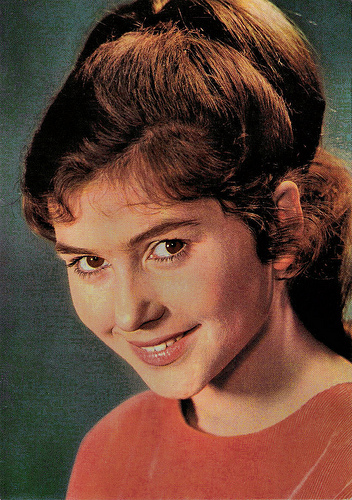
East-German postcard by VEB Progress Film-Vertrieb, no. 3538, 1966. Photo: DEFA / Schwarzer. Publicity still for Der geteilte Himmel/Divided Heaven (Konrad Wolf, 1964).

Big East-German card by VEB Progress Film-Vertrieb, no. 2/74, 1974. Photo: Linke.

With Dean Reed . Romanian postcard by Casa Filmului Acin, no. 43080.
Divided Heaven
Renate Blume was born in Bad Wildungen, Germany, in 1944. As a twelve-year-old she joined the Gret Palucca ballet school in Dresden. Although her parents wanted her to became a doctor, she secretly applied to the Academy for Performing Arts in Berlin.
While still a student, she played her first leading role in the DEFA drama Der geteilte Himmel/Divided Heaven (Konrad Wolf, 1964). The East-German film, based on Christa Wolf's novel Divided Heaven (1963), is set in the period immediately before the Berlin Wall was built.
Blume is Rita Seidel, who recalls the last two years, in which she fell in love with Manfred (Eberhard Esche), a chemist who is ten years older. As Manfred became disillusioned with his opportunities in East Germany, he moved to the West. Rita followed him there and tried to persuade him to return but soon realised he would never do it.
The film became an international success, thanks in part to Blume’s naturalistic and honest performance. Although some of the characters are shown as overzealous in their support of the regime, for obvious reasons the nature of the East German dictatorship is never depicted or discussed. The Stasi, the all-pervasive secret police headed by the director's brother Markus Wolf, is not mentioned.
The film was removed from circulation on several occasions in the following years, when the Socialist Unity Party of Germany decreed it, depending on the political situation In 1995, a group of historians and cinema researchers chose Der geteilte Himmel/Divided Heaven as one of the 100 most important German films ever made.
Three years later she appeared in the two-part war film Die gefrorenen Blitze/Frozen Flashes (János Veiczi, 1967) which tells the history of the resistance movement in Peenemünde during the Second World War and its attempt to sabotage the V-2 program. Among the large cast were also Alfred Müller, Leon Niemczyk and Mikhail Ulyanov. From 1965 to 1970, Blume was a member of the Dresdner Staatstheater ensemble, where she continued giving guest performances until 1986.
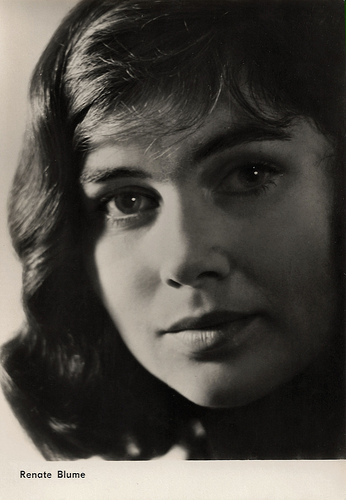
East-German postcard by VEB Progress Film-Vertrieb, no. 2.159, 1964. Photo: DEFA / Schwarzer. Publicity still for Der geteilte Himmel/Divided Heaven (Konrad Wolf, 1964).
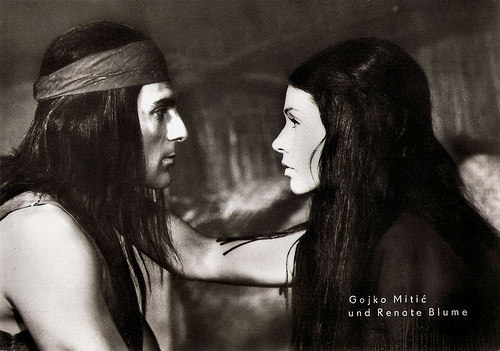
East-German postcard by VEB Progress Film-Vertrieb, no. 65/74, 1974. Photo: DEFA / Dassdorf. Publicity still for Ulzana (Gottfried Kolditz, 1974) with Gojko Mitic .
Ulzana
In 1970, Renate Blume joined the East German television ensemble and acted in over 40 TV productions over the next 20 years. Although Blume regularly appeared on TV, she rarely worked in the cinema.
In 1974, she co-starred in the Eastern Ulzana (Gottfried Kolditz, 1974), as the wife of Gojko Mitic ,the chief of the Mimbrero tribe. It was followed by the comic Eastern Kit & Co. (Konrad Petzold, 1974) with Dean Reed , an American actor, singer and songwriter, living in East Germany.
Blume appeared in Archiv des Todes/Archives of Death (1980). This 13-part East German war television series was set during World War II and also starred Gojko Mitic , Leon Niemczyk and Barbara Brylska.
In the cinema, Blume appeared in the fantasy Der Prinz hinter den sieben Meeren/The Prince of the Seven Seas (Walter Beck, 1982). After the Wende, Blume played a supporting part in the family film Die Distel/The Thistle (Gernot Krää, 1992) with Katja Riemann . In between she appeared in popular TV series such as Polizeiruf 110/Police Call 110 (1978-1998).
Since the Wall came down, she has taught performing arts, performed at theaters in Berlin, Dresden, Hamburg, and Munich, and acted in TV movies and TV series. In the cinema, she played a small part in the film Sternzeichen/Zodiac Sign (Peter Patzak, 2003) as the wife of Vadim Glowna. More recently she appeared in TV series such as Fünf Sterne/Five Stars (2005-2008) with Ralph Bauer, and Schloss Einstein (2008-2009) about students at a boarding school in Erfurt.
From 1969 until 1975 Blume was married with film director Frank Beyer. Their son Alexander also became an actor. From 1974 till 1976 she lived together with Romanian actor Gojko Mitic . In 1981, she married Dean Reed , but he died in 1986.
In 2007, Renate Blume was featured in Der Rote Elvis/The Red Elvis (2007), a German documentary about Reed’s life. Her most recent screen appearance was in the TV-Krimi Lindburgs Fall/Prime Time Crime (Franziska Meyer Price, 2011) with Fritz Wepper.
Sources: DEFA Film Library, Wikipedia (German and English) and .

East-German postcard by VEB Progress Film-Vertrieb, no. 3538, 1966. Photo: DEFA / Schwarzer. Publicity still for Der geteilte Himmel/Divided Heaven (Konrad Wolf, 1964).

Big East-German card by VEB Progress Film-Vertrieb, no. 2/74, 1974. Photo: Linke.

With Dean Reed . Romanian postcard by Casa Filmului Acin, no. 43080.
Divided Heaven
Renate Blume was born in Bad Wildungen, Germany, in 1944. As a twelve-year-old she joined the Gret Palucca ballet school in Dresden. Although her parents wanted her to became a doctor, she secretly applied to the Academy for Performing Arts in Berlin.
While still a student, she played her first leading role in the DEFA drama Der geteilte Himmel/Divided Heaven (Konrad Wolf, 1964). The East-German film, based on Christa Wolf's novel Divided Heaven (1963), is set in the period immediately before the Berlin Wall was built.
Blume is Rita Seidel, who recalls the last two years, in which she fell in love with Manfred (Eberhard Esche), a chemist who is ten years older. As Manfred became disillusioned with his opportunities in East Germany, he moved to the West. Rita followed him there and tried to persuade him to return but soon realised he would never do it.
The film became an international success, thanks in part to Blume’s naturalistic and honest performance. Although some of the characters are shown as overzealous in their support of the regime, for obvious reasons the nature of the East German dictatorship is never depicted or discussed. The Stasi, the all-pervasive secret police headed by the director's brother Markus Wolf, is not mentioned.
The film was removed from circulation on several occasions in the following years, when the Socialist Unity Party of Germany decreed it, depending on the political situation In 1995, a group of historians and cinema researchers chose Der geteilte Himmel/Divided Heaven as one of the 100 most important German films ever made.
Three years later she appeared in the two-part war film Die gefrorenen Blitze/Frozen Flashes (János Veiczi, 1967) which tells the history of the resistance movement in Peenemünde during the Second World War and its attempt to sabotage the V-2 program. Among the large cast were also Alfred Müller, Leon Niemczyk and Mikhail Ulyanov. From 1965 to 1970, Blume was a member of the Dresdner Staatstheater ensemble, where she continued giving guest performances until 1986.

East-German postcard by VEB Progress Film-Vertrieb, no. 2.159, 1964. Photo: DEFA / Schwarzer. Publicity still for Der geteilte Himmel/Divided Heaven (Konrad Wolf, 1964).

East-German postcard by VEB Progress Film-Vertrieb, no. 65/74, 1974. Photo: DEFA / Dassdorf. Publicity still for Ulzana (Gottfried Kolditz, 1974) with Gojko Mitic .
Ulzana
In 1970, Renate Blume joined the East German television ensemble and acted in over 40 TV productions over the next 20 years. Although Blume regularly appeared on TV, she rarely worked in the cinema.
In 1974, she co-starred in the Eastern Ulzana (Gottfried Kolditz, 1974), as the wife of Gojko Mitic ,the chief of the Mimbrero tribe. It was followed by the comic Eastern Kit & Co. (Konrad Petzold, 1974) with Dean Reed , an American actor, singer and songwriter, living in East Germany.
Blume appeared in Archiv des Todes/Archives of Death (1980). This 13-part East German war television series was set during World War II and also starred Gojko Mitic , Leon Niemczyk and Barbara Brylska.
In the cinema, Blume appeared in the fantasy Der Prinz hinter den sieben Meeren/The Prince of the Seven Seas (Walter Beck, 1982). After the Wende, Blume played a supporting part in the family film Die Distel/The Thistle (Gernot Krää, 1992) with Katja Riemann . In between she appeared in popular TV series such as Polizeiruf 110/Police Call 110 (1978-1998).
Since the Wall came down, she has taught performing arts, performed at theaters in Berlin, Dresden, Hamburg, and Munich, and acted in TV movies and TV series. In the cinema, she played a small part in the film Sternzeichen/Zodiac Sign (Peter Patzak, 2003) as the wife of Vadim Glowna. More recently she appeared in TV series such as Fünf Sterne/Five Stars (2005-2008) with Ralph Bauer, and Schloss Einstein (2008-2009) about students at a boarding school in Erfurt.
From 1969 until 1975 Blume was married with film director Frank Beyer. Their son Alexander also became an actor. From 1974 till 1976 she lived together with Romanian actor Gojko Mitic . In 1981, she married Dean Reed , but he died in 1986.
In 2007, Renate Blume was featured in Der Rote Elvis/The Red Elvis (2007), a German documentary about Reed’s life. Her most recent screen appearance was in the TV-Krimi Lindburgs Fall/Prime Time Crime (Franziska Meyer Price, 2011) with Fritz Wepper.
Sources: DEFA Film Library, Wikipedia (German and English) and .
Published on March 18, 2018 23:00
March 17, 2018
Ray Danton
American actor Ray Danton (1931-1992) was a handsome and smooth natured leading man who often played oily individuals in Hollywood film and TV series. He also worked in Europe where he directed some film too.
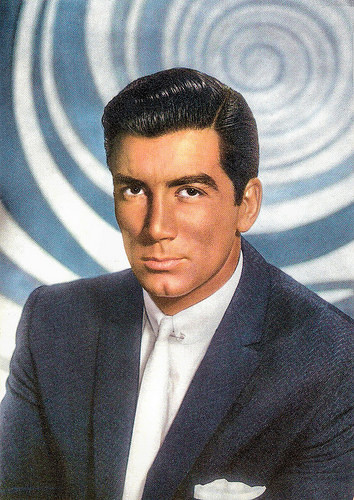
Italian postcard by Rotalcolor, Milano, no. N. 139.
A smooth but dangerous villain
Ray Danton was born Raymond Caplan in New York in 1931. Raymond was the son of Myrtle (née Menkin) and Jack Caplan. Danton entered show business as a child radio actor on NBC radio's Let's Pretend show in 1943.
Danton did many stage roles whilst attending the University of Pittsburgh. He was dramatically trained at Carnegie Tech and in 1950 went to London to appear on stage in the Tyrone Power production Mister Roberts. Danton's acting career was put on hold when he served in the United States Army infantry during the Korean War from 1951–1954.
His on-screen debut was as a moody Native American opposite Victor Mature in Chief Crazy Horse (George Sherman, 1955), a biography of the famous Lakota Sioux war chief which was told entirely from the Indian viewpoint. He was contracted to Universal Pictures.
He next played a supporting part as a smooth but dangerous villain in I'll Cry Tomorrow (Daniel Mann, 1955) starring Susan Hayward. For this part he won the Golden Globe as Most Promising Newcomer.
At the set of his third film for Universal The Looters (Abner Biberman, 1955) he met his future wife Julie Adams. Danton guest-starred in many 1950s TV shows including Playhouse 90 (1956), Wagon Train (1957), and 77 Sunset Strip (1958), often as a gunslinger or a slippery criminal.
Danton found plenty of demand for his talents and appeared in several minor films including the Film Noir The Night Runner (Abner Biberman,1957), the war film Tarawa Beachhead (Paul Wendkos, 1958), in which he starred with his wife, Julie Adams, and then as a serial rapist in The Beat Generation (Charles F. Haas, 1959) opposite Steve Cochran and Mamie van Doren .
However, his most well remembered role was as the vicious prohibition gangster Jack Diamond in The Rise and Fall of Legs Diamond (1960) also starring a young Warren Oates and directed by Budd Boetticher. Wikipedia : "Danton played his role using dynamic body language with his smooth persona fitting the character like a glove." Danton reprised his Legs Diamond role only a year later in the unrelated, and not as enjoyable Portrait of a Mobster (Joseph Pevney, 1961).
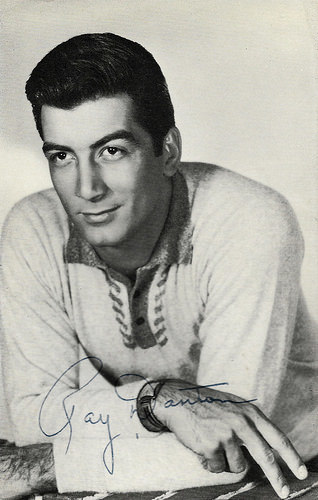
British postcard in the Celebrity Autograph Series by Celebrity Publishers LTD., London, no. 2789. Photo: Universal-International. Publicity still for The Night Runner (Abner Biberman, 1957).
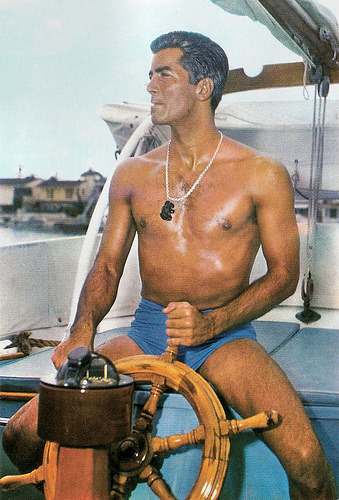
Spanish postcard by Raker, no. 1126.
Europe beckoned
Cornering the market on playing shady characters, Ray Danton then portrayed troubled actor George Raft in The George Raft Story (Joseph M. Newman, 1961) with Jayne Mansfield , but he was back on the side of good in 1962 playing an Allied officer at the invasion of Normandy in The Longest Day (Ken Annakin, Andrew Marton, Bernhard Wicki, 1962).
Europe then beckoned for the virile Danton, and like many other young US actors in the early 1960s, he made several films in Italy and Spain between 1964 and 1969 with a mixture of success. These films included Sandokan alla riscossa/Sandokan Fights Back (Luigi Capuano, 1964) with Guy Madison , and the Europsy films Corrida pour un espion/Code Name: Jaguar (Maurice Labro, 1965) with Pascale Petit, and New York chiama Superdrago/Secret Agent Super Dragon (Giorgio Ferroni, 1966) with Marisa Mell and Margaret Lee .
Danton returned to the USA in the early 1970s, but also ran his own production company in Barcelona, Spain. In Europe he directed the AIP production of Deathmaster (Ray Danton, 1972) starring Robert Quarry who was riding high on the success of the Count Yorga vampire films. Danton also co-directed La tumba de la isla maldita/Crypt of the Living Deads (Julio Salvador, Ray Danton, 1973) with Mark Damon.
Later he became involved in television and directed episodes of some of the most popular TV series of the 1970s and 1980s, including Quincy M.E. (1976), The Incredible Hulk (1978), Magnum, P.I. (1980), Dynasty (1981), and Cagney & Lacey (1981). His final directorial work was an episode for the TV series Mike Hammer (1989).
Ray Danton passed away in 1992 from kidney failure. He was only 61. He was divorced of his wife, Julie Adams, in 1978 ( IMDb ) or 1981 ( Wikipedia ). They had two sons, assistant director Steve Danton (1956) and editor Mitchell Danton (1962). His companion at the time of his death was actress Jeannie Austin, who was cast in a couple of TV episodes Ray directed, including Magnum, P.I. (1980).
Trailer for The George Raft Story (Joseph M. Newman, 1961). Source: horrormovieshows (YouTube).
Trailer for the EuroSpy adventure New York chiama Superdrago/Secret Agent Super Dragon (Giorgio Ferroni, 1966). Source: Night Of The Trailers (YouTube).
Sources: Wikipedia and .

Italian postcard by Rotalcolor, Milano, no. N. 139.
A smooth but dangerous villain
Ray Danton was born Raymond Caplan in New York in 1931. Raymond was the son of Myrtle (née Menkin) and Jack Caplan. Danton entered show business as a child radio actor on NBC radio's Let's Pretend show in 1943.
Danton did many stage roles whilst attending the University of Pittsburgh. He was dramatically trained at Carnegie Tech and in 1950 went to London to appear on stage in the Tyrone Power production Mister Roberts. Danton's acting career was put on hold when he served in the United States Army infantry during the Korean War from 1951–1954.
His on-screen debut was as a moody Native American opposite Victor Mature in Chief Crazy Horse (George Sherman, 1955), a biography of the famous Lakota Sioux war chief which was told entirely from the Indian viewpoint. He was contracted to Universal Pictures.
He next played a supporting part as a smooth but dangerous villain in I'll Cry Tomorrow (Daniel Mann, 1955) starring Susan Hayward. For this part he won the Golden Globe as Most Promising Newcomer.
At the set of his third film for Universal The Looters (Abner Biberman, 1955) he met his future wife Julie Adams. Danton guest-starred in many 1950s TV shows including Playhouse 90 (1956), Wagon Train (1957), and 77 Sunset Strip (1958), often as a gunslinger or a slippery criminal.
Danton found plenty of demand for his talents and appeared in several minor films including the Film Noir The Night Runner (Abner Biberman,1957), the war film Tarawa Beachhead (Paul Wendkos, 1958), in which he starred with his wife, Julie Adams, and then as a serial rapist in The Beat Generation (Charles F. Haas, 1959) opposite Steve Cochran and Mamie van Doren .
However, his most well remembered role was as the vicious prohibition gangster Jack Diamond in The Rise and Fall of Legs Diamond (1960) also starring a young Warren Oates and directed by Budd Boetticher. Wikipedia : "Danton played his role using dynamic body language with his smooth persona fitting the character like a glove." Danton reprised his Legs Diamond role only a year later in the unrelated, and not as enjoyable Portrait of a Mobster (Joseph Pevney, 1961).

British postcard in the Celebrity Autograph Series by Celebrity Publishers LTD., London, no. 2789. Photo: Universal-International. Publicity still for The Night Runner (Abner Biberman, 1957).

Spanish postcard by Raker, no. 1126.
Europe beckoned
Cornering the market on playing shady characters, Ray Danton then portrayed troubled actor George Raft in The George Raft Story (Joseph M. Newman, 1961) with Jayne Mansfield , but he was back on the side of good in 1962 playing an Allied officer at the invasion of Normandy in The Longest Day (Ken Annakin, Andrew Marton, Bernhard Wicki, 1962).
Europe then beckoned for the virile Danton, and like many other young US actors in the early 1960s, he made several films in Italy and Spain between 1964 and 1969 with a mixture of success. These films included Sandokan alla riscossa/Sandokan Fights Back (Luigi Capuano, 1964) with Guy Madison , and the Europsy films Corrida pour un espion/Code Name: Jaguar (Maurice Labro, 1965) with Pascale Petit, and New York chiama Superdrago/Secret Agent Super Dragon (Giorgio Ferroni, 1966) with Marisa Mell and Margaret Lee .
Danton returned to the USA in the early 1970s, but also ran his own production company in Barcelona, Spain. In Europe he directed the AIP production of Deathmaster (Ray Danton, 1972) starring Robert Quarry who was riding high on the success of the Count Yorga vampire films. Danton also co-directed La tumba de la isla maldita/Crypt of the Living Deads (Julio Salvador, Ray Danton, 1973) with Mark Damon.
Later he became involved in television and directed episodes of some of the most popular TV series of the 1970s and 1980s, including Quincy M.E. (1976), The Incredible Hulk (1978), Magnum, P.I. (1980), Dynasty (1981), and Cagney & Lacey (1981). His final directorial work was an episode for the TV series Mike Hammer (1989).
Ray Danton passed away in 1992 from kidney failure. He was only 61. He was divorced of his wife, Julie Adams, in 1978 ( IMDb ) or 1981 ( Wikipedia ). They had two sons, assistant director Steve Danton (1956) and editor Mitchell Danton (1962). His companion at the time of his death was actress Jeannie Austin, who was cast in a couple of TV episodes Ray directed, including Magnum, P.I. (1980).
Trailer for The George Raft Story (Joseph M. Newman, 1961). Source: horrormovieshows (YouTube).
Trailer for the EuroSpy adventure New York chiama Superdrago/Secret Agent Super Dragon (Giorgio Ferroni, 1966). Source: Night Of The Trailers (YouTube).
Sources: Wikipedia and .
Published on March 17, 2018 23:00
March 16, 2018
Oleg Tabakov (1935-2018)
On 12 March 2018,
Soviet and Russian actor Oleg Tabakov (1935) passed away. Tabakov performed in both classic and modern plays and was artistic director of the Moscow Art Theatre. His film career was equally impressive with roles as Count Nikita Rostov in Voyna i mir I/War and Peace (1966-1967) by Sergei Bondarchuk, and as the title figure in Oblomow (1981) by Nikita Mikhalkov. Tabakov was 82.
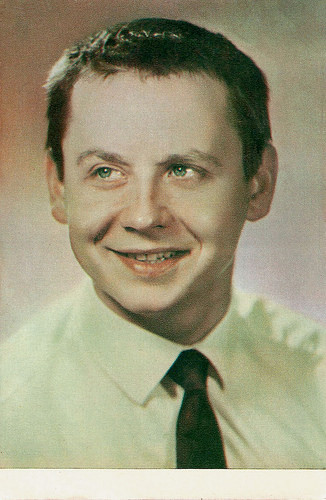
Russian postcard by Izdanije Byuro Propogandy Sovietskogo Kinoiskusstva, no. A 11212. Photo: B. Vilenkina, G. Ter-Ovanesova.
War and Peace
Oleg Pavlovich Tabakov (Russian: Олег Павлович Табаков) was born in Saratov, USSR (now Saratovskaya oblast, Russia) in 1935. His father, Pavel Kongratevich, and his mother, Maria Andreevna Berezovskaya, were medical doctors in Saratov. His parents separated during the Second World War, and young Tabakov was brought up by his single mother and grandmother.
Oleg attended the all-boys school in Saratov, and was active in the drama class. From 1950-1953 he studied acting at the Saratov House of Pioneers under the legendary acting coach Natalia Iosifivna Sukhostav. In 1953, Tabakov moved to Moscow and studied at the Moscow Art Theatre School.
In 1957 he graduated from the school, and became one of the founding fathers of the Sovremennik Theatre. There he played leading roles in such productions as Goly Korol (Naked King), Tri Zhelaniya (Three Wishes), Obyknovennaya istoriya (Ordinary story) and other contemporary Russian plays. From 1970 till 1976 Tabakov was General Manager of Sovremennik, he promoted Galina Volchek to Principal Director of the company.
He administrated the Sovremennik until 1982, when he moved to the Moscow Art Theatre, where he played Molière and Salieri for over 20 years. In 1986, Tabakov persuaded his students to form the Tabakov Studio attached to the Moscow Art Theatre. Several notable Russian actors including Yevgeny Mironov, Sergey Bezrukov, Vladimir Mashkov, Andrey Smolyakov and Alexandre Marine studied at the studio.
Tabakov also spread his theatre's ideals abroad. His teaching credentials include workshops and productions at the Paris Conservatoire, the British American Drama Academy, Akademie Der Künst in Hamburg, the Max Reinhardt Seminar in Vienna, Carnegie Mellon, The Juilliard School, New York University, Florida State University, The University of Delaware, and Harvard University.
For his stage work he won several medals an honours. Tabakov's film career paralleled his theatrical career. He made his film debut as Sasha in the drama Sasha vstupayet v zhizn/Sasha Enters Life (Mikhail Shvejtser, 1957). Soon followed roles in the crime drama Ispytatelnyy Srok/The Probation (Vladimir Gerasimov, 1960) and the war drama Chistoe nebo/Clear Skies (Grigori Chukhrai, 1961) with Yevgeni Urbansky . He appeared in the role of Nikolai Rostov in Sergei Bondarchuk 's Voyna i mir I/War and Peace (1966–1967),
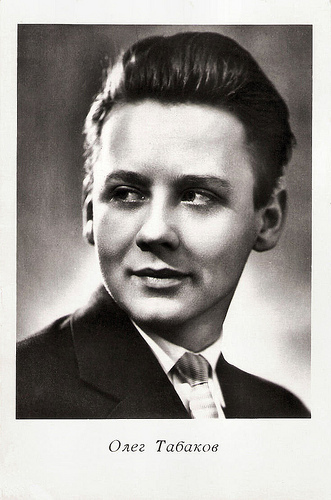
Russian postcard by Izdanije Byuro Propogandy Sovietskogo Kinoiskusstva, no. 3744, 1963.
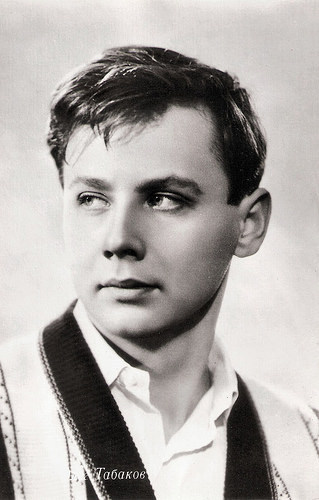
Russian postcard by Izdanije Byuro Propogandy Sovietskogo Kinoiskusstva, no. A 07154.
Moscow Does Not Believe In Tears
Oleg Tabakov played the lead role in the comedy-drama Gori, gori, moya zvezda/Shine, Shine, My Star (Aleksandr Mitta, 1970). Then followed parts in popular TV series as Semnadtsat mgnoveniy vesny/Seventeen Instants of Spring (Tatyana Lioznova, 1973), starring Vyacheslav Tikhonov, and D'Artanyan i tri mushketyora/D'Artagnan and Three Musketeers (Georgi Yungvald-Khilkevich, 1978).
An international success was Neokonchennaya pyesa dlya mekhanicheskogo pianino/An Unfinished Piece for a Piano Player (Nikita Mikhalkov, 1977). His later films include the Academy Award-winning Moskva slezam ne verit/Moscow Does Not Believe In Tears (Vladimir Menshov, 1980), the international art house hits Oblomov (Nikita Mikhalkov, 1981) and Oci ciornie/Dark Eyes (Nikita Mikhalkov, 1986) starring Marcello Mastroianni .
Tabakov also played in the mock slapstick Western Chelovek s bulvara Kaputsinov/A Man from the Boulevard des Capuchines (Alla Surikova, 1987) about Mr Jonny First (Andei Mironov), who arrives in the Wild West to present the art of the Cinematograph. Over 40 million people in the USSR paid to see the feature.
Tabakov has lend his distinctive, purr-like voice to a number of animated characters, including the talking cat Matroskin in the animation film Kanikuly v Prostokvashino/Three from Prostokvashino (Vladimir Popov, 1980) and its sequels. After the Matroskin role he dubbed the character of Garfield into Russian in the feature film Garfield (Peter Hewitt, 2004).
During the 1990s, Oleg Tabakov was a strong supporter of democratic reforms and freedom in the new Russia. He made public speeches and was involved in many public events facilitating the cultural transformation of arts and theatres in Russia. He also continued to appear in films, such as in The Inner Circle (Andrey Konchalovskiy, 1991), about Stalin's private film projectionist from (Tom Hulce), the TV movie Stalin (Ivan Passer, 1992) with Robert Duvall, and Taking Sides (István Szabó, 2001) with Harvey Keitel.
Oleg Tabakov was designated People's Actor of the USSR and Russia in the 1980s, and was decorated with the Order of Merit of Fatherland II degree, by the Russian president, Vladimir Putin, in 2005. During the 2012 Russian presidential election Tabakov was registered as a ‘Trusted Representative’ of Putin. In March 2014, he signed a letter in support of the position of Putin on Russia's military intervention in Ukraine.
His last films were the comedies Kukhnya v Parizhe/A Kitchen in Paris (Dmitriy Dyachenko, 2014) with Vincent Perez, and the sequel Kukhnya. Poslednyaya bitva/Kitchen. The Last Battle (Anton Fedotov, 2017).
In November 2017, Oleg Tabakov was hospitalised with sepsis. In December, Tabakov's condition deteriorated sharply - he fell into a pre-coma condition. On 12 March 2018, he died of a heart attack at age 82. The farewell ceremony took place at the Moscow Art Theatre named after Chekhov's historical stage where Tabakov worked as a artistic director and plays director for many years.
Oleg Tabakov was married twice. His first wife was actress Lyudmila Krylova (1960–1994) with whom he has two children. Their son Anton Tabakov is an actor and also a successful night-club owner in Moscow. Since 1994 Oleg Tabakov was married to actress Marina Zudina. The couple had two children, son Pavel (1996), and daughter Maria (2006).
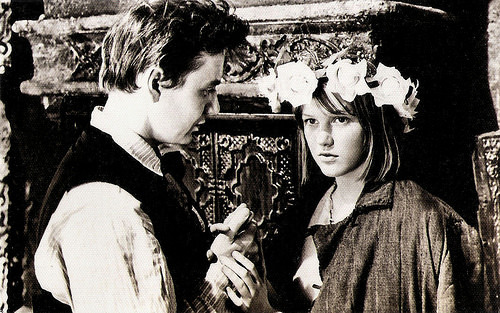
Russian postcard by Izdanije Byuro Propogandy Sovietskogo Kinoiskusstva, no. 1984. Publicity still for Gori, Gori, Moya Zvezda (Aleksandr Mitta, 1970) with Elena Proklova.
Sources: (IMDb), AllMovie, Wikipedia, and .

Russian postcard by Izdanije Byuro Propogandy Sovietskogo Kinoiskusstva, no. A 11212. Photo: B. Vilenkina, G. Ter-Ovanesova.
War and Peace
Oleg Pavlovich Tabakov (Russian: Олег Павлович Табаков) was born in Saratov, USSR (now Saratovskaya oblast, Russia) in 1935. His father, Pavel Kongratevich, and his mother, Maria Andreevna Berezovskaya, were medical doctors in Saratov. His parents separated during the Second World War, and young Tabakov was brought up by his single mother and grandmother.
Oleg attended the all-boys school in Saratov, and was active in the drama class. From 1950-1953 he studied acting at the Saratov House of Pioneers under the legendary acting coach Natalia Iosifivna Sukhostav. In 1953, Tabakov moved to Moscow and studied at the Moscow Art Theatre School.
In 1957 he graduated from the school, and became one of the founding fathers of the Sovremennik Theatre. There he played leading roles in such productions as Goly Korol (Naked King), Tri Zhelaniya (Three Wishes), Obyknovennaya istoriya (Ordinary story) and other contemporary Russian plays. From 1970 till 1976 Tabakov was General Manager of Sovremennik, he promoted Galina Volchek to Principal Director of the company.
He administrated the Sovremennik until 1982, when he moved to the Moscow Art Theatre, where he played Molière and Salieri for over 20 years. In 1986, Tabakov persuaded his students to form the Tabakov Studio attached to the Moscow Art Theatre. Several notable Russian actors including Yevgeny Mironov, Sergey Bezrukov, Vladimir Mashkov, Andrey Smolyakov and Alexandre Marine studied at the studio.
Tabakov also spread his theatre's ideals abroad. His teaching credentials include workshops and productions at the Paris Conservatoire, the British American Drama Academy, Akademie Der Künst in Hamburg, the Max Reinhardt Seminar in Vienna, Carnegie Mellon, The Juilliard School, New York University, Florida State University, The University of Delaware, and Harvard University.
For his stage work he won several medals an honours. Tabakov's film career paralleled his theatrical career. He made his film debut as Sasha in the drama Sasha vstupayet v zhizn/Sasha Enters Life (Mikhail Shvejtser, 1957). Soon followed roles in the crime drama Ispytatelnyy Srok/The Probation (Vladimir Gerasimov, 1960) and the war drama Chistoe nebo/Clear Skies (Grigori Chukhrai, 1961) with Yevgeni Urbansky . He appeared in the role of Nikolai Rostov in Sergei Bondarchuk 's Voyna i mir I/War and Peace (1966–1967),

Russian postcard by Izdanije Byuro Propogandy Sovietskogo Kinoiskusstva, no. 3744, 1963.

Russian postcard by Izdanije Byuro Propogandy Sovietskogo Kinoiskusstva, no. A 07154.
Moscow Does Not Believe In Tears
Oleg Tabakov played the lead role in the comedy-drama Gori, gori, moya zvezda/Shine, Shine, My Star (Aleksandr Mitta, 1970). Then followed parts in popular TV series as Semnadtsat mgnoveniy vesny/Seventeen Instants of Spring (Tatyana Lioznova, 1973), starring Vyacheslav Tikhonov, and D'Artanyan i tri mushketyora/D'Artagnan and Three Musketeers (Georgi Yungvald-Khilkevich, 1978).
An international success was Neokonchennaya pyesa dlya mekhanicheskogo pianino/An Unfinished Piece for a Piano Player (Nikita Mikhalkov, 1977). His later films include the Academy Award-winning Moskva slezam ne verit/Moscow Does Not Believe In Tears (Vladimir Menshov, 1980), the international art house hits Oblomov (Nikita Mikhalkov, 1981) and Oci ciornie/Dark Eyes (Nikita Mikhalkov, 1986) starring Marcello Mastroianni .
Tabakov also played in the mock slapstick Western Chelovek s bulvara Kaputsinov/A Man from the Boulevard des Capuchines (Alla Surikova, 1987) about Mr Jonny First (Andei Mironov), who arrives in the Wild West to present the art of the Cinematograph. Over 40 million people in the USSR paid to see the feature.
Tabakov has lend his distinctive, purr-like voice to a number of animated characters, including the talking cat Matroskin in the animation film Kanikuly v Prostokvashino/Three from Prostokvashino (Vladimir Popov, 1980) and its sequels. After the Matroskin role he dubbed the character of Garfield into Russian in the feature film Garfield (Peter Hewitt, 2004).
During the 1990s, Oleg Tabakov was a strong supporter of democratic reforms and freedom in the new Russia. He made public speeches and was involved in many public events facilitating the cultural transformation of arts and theatres in Russia. He also continued to appear in films, such as in The Inner Circle (Andrey Konchalovskiy, 1991), about Stalin's private film projectionist from (Tom Hulce), the TV movie Stalin (Ivan Passer, 1992) with Robert Duvall, and Taking Sides (István Szabó, 2001) with Harvey Keitel.
Oleg Tabakov was designated People's Actor of the USSR and Russia in the 1980s, and was decorated with the Order of Merit of Fatherland II degree, by the Russian president, Vladimir Putin, in 2005. During the 2012 Russian presidential election Tabakov was registered as a ‘Trusted Representative’ of Putin. In March 2014, he signed a letter in support of the position of Putin on Russia's military intervention in Ukraine.
His last films were the comedies Kukhnya v Parizhe/A Kitchen in Paris (Dmitriy Dyachenko, 2014) with Vincent Perez, and the sequel Kukhnya. Poslednyaya bitva/Kitchen. The Last Battle (Anton Fedotov, 2017).
In November 2017, Oleg Tabakov was hospitalised with sepsis. In December, Tabakov's condition deteriorated sharply - he fell into a pre-coma condition. On 12 March 2018, he died of a heart attack at age 82. The farewell ceremony took place at the Moscow Art Theatre named after Chekhov's historical stage where Tabakov worked as a artistic director and plays director for many years.
Oleg Tabakov was married twice. His first wife was actress Lyudmila Krylova (1960–1994) with whom he has two children. Their son Anton Tabakov is an actor and also a successful night-club owner in Moscow. Since 1994 Oleg Tabakov was married to actress Marina Zudina. The couple had two children, son Pavel (1996), and daughter Maria (2006).

Russian postcard by Izdanije Byuro Propogandy Sovietskogo Kinoiskusstva, no. 1984. Publicity still for Gori, Gori, Moya Zvezda (Aleksandr Mitta, 1970) with Elena Proklova.
Sources: (IMDb), AllMovie, Wikipedia, and .
Published on March 16, 2018 23:00
March 15, 2018
Cox
In Belgium a series of film star cards was published by Cox, an Import-Export firm. The series was produced in the 1950s and is remarkable because the cards have pictures at both sides. At the front is a colour picture of the star and the flipside shows a photo in black and white. Many of the stars were German, but there are also French, British and American artists in the series. In this post we show mainly the colour pictures, but also a few of the black and white sides.
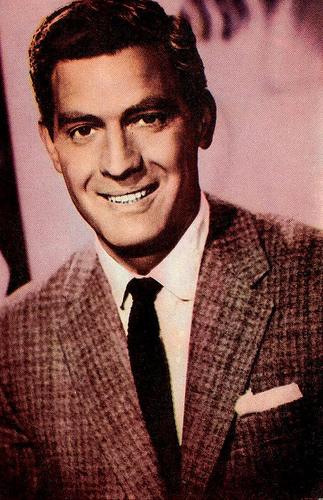
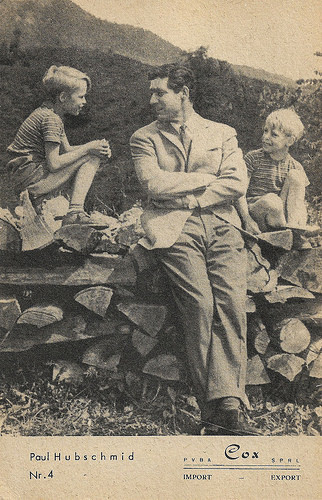
Paul Hubschmid . Belgian card by Cox, no. 4.
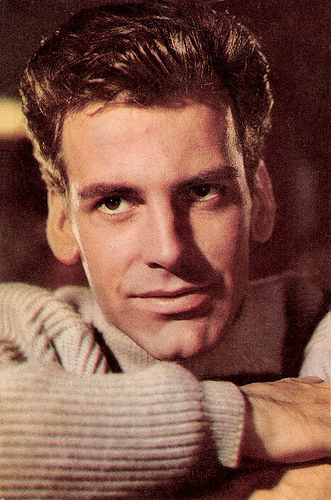
Maximilian Schell . Belgian card by Cox, no. 7.
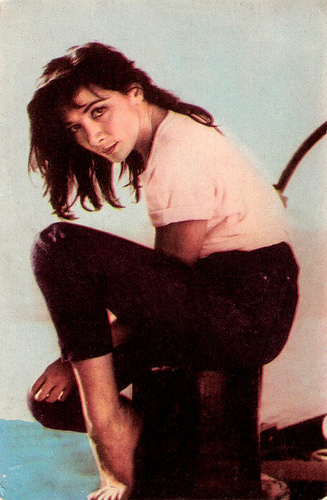
Juliette Gréco. Belgian card by Cox, no. 10.

Carlos Thompson . Belgian card by Cox, no. 18. Publicity still for Das Wirtshaus im Spessart/The Spessart Inn (Kurt Hoffmann, 1957).
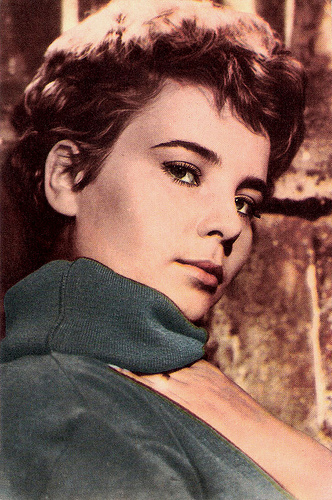
Corny Collins. Belgian card by Cox, no. 19.
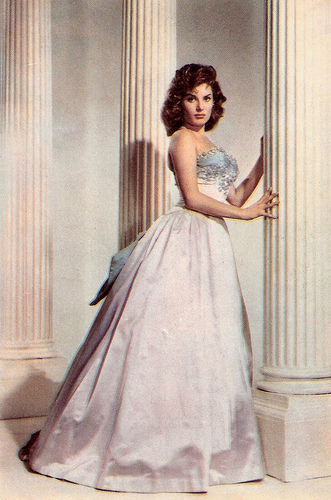
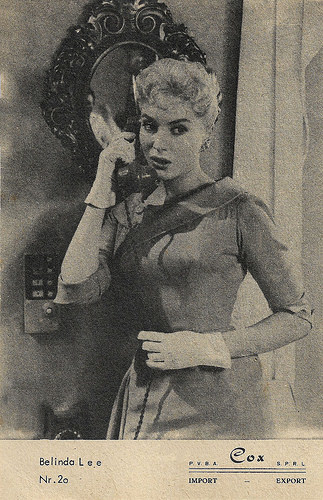
Belinda Lee . Belgian card by Cox, no. 20.
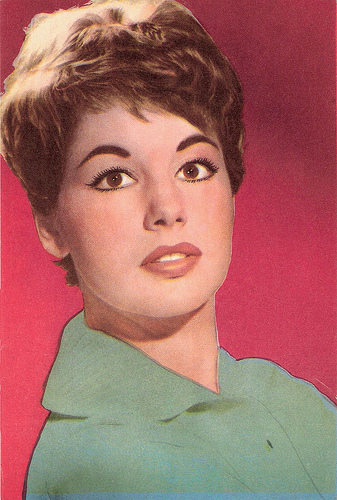
Johanna von Koczian . Belgian card by Cox, no. 23.
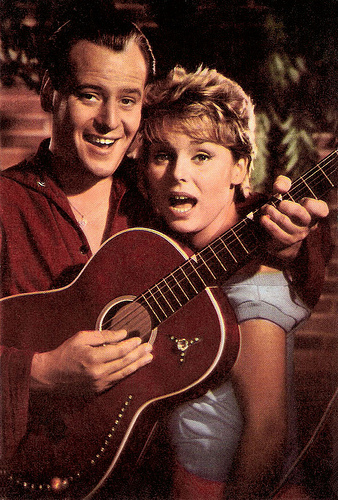
Fred Bertelmann and Conny Froboess . Belgian card by Cox, no. 25.
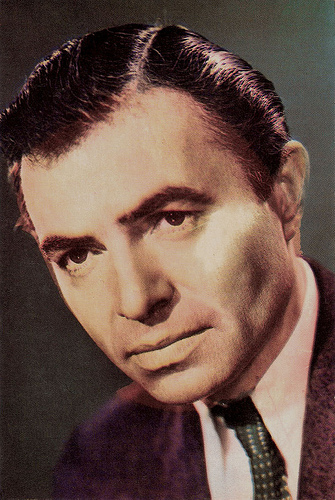
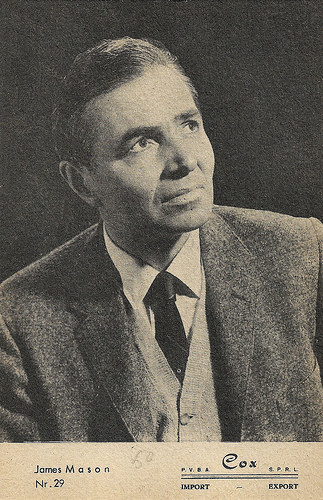
James Mason . Belgian card by Cox, no. 29.
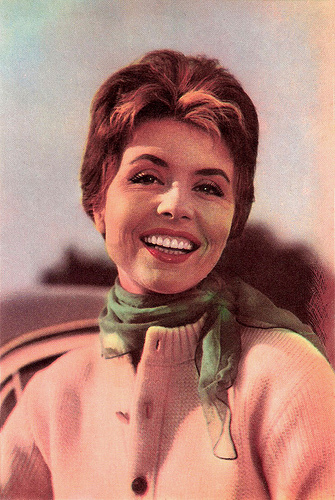
Sonja Ziemann . Belgian card by Cox, no. 33.
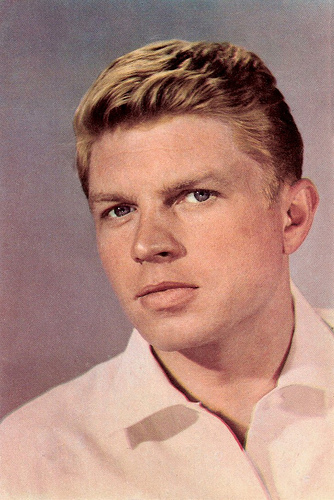
Hardy Krüger . Belgian card by Cox, no. 35.
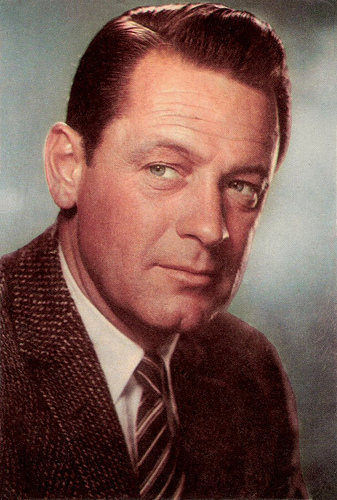
William Holden. Belgian card by Cox, no. 36.
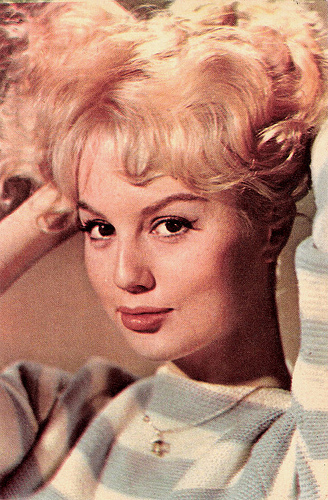
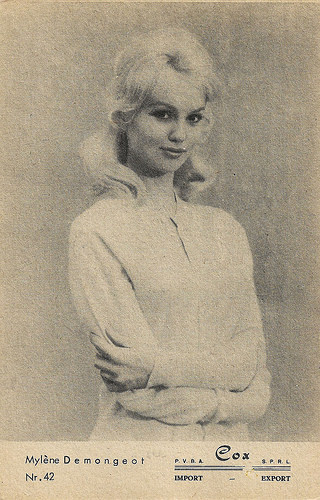
Mylène Demongeot . Belgian card by Cox, no. 42.
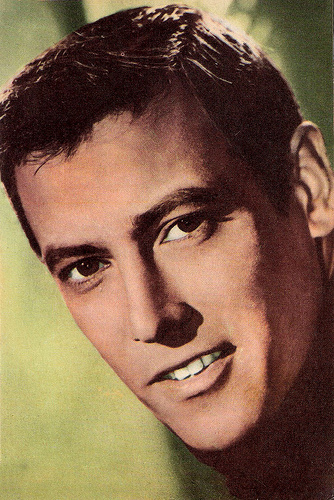
Dietmar Schönherr . Belgian postcard by Cox, no. 49.


Paul Hubschmid . Belgian card by Cox, no. 4.

Maximilian Schell . Belgian card by Cox, no. 7.

Juliette Gréco. Belgian card by Cox, no. 10.

Carlos Thompson . Belgian card by Cox, no. 18. Publicity still for Das Wirtshaus im Spessart/The Spessart Inn (Kurt Hoffmann, 1957).

Corny Collins. Belgian card by Cox, no. 19.


Belinda Lee . Belgian card by Cox, no. 20.

Johanna von Koczian . Belgian card by Cox, no. 23.

Fred Bertelmann and Conny Froboess . Belgian card by Cox, no. 25.


James Mason . Belgian card by Cox, no. 29.

Sonja Ziemann . Belgian card by Cox, no. 33.

Hardy Krüger . Belgian card by Cox, no. 35.

William Holden. Belgian card by Cox, no. 36.


Mylène Demongeot . Belgian card by Cox, no. 42.

Dietmar Schönherr . Belgian postcard by Cox, no. 49.
Published on March 15, 2018 23:00
March 14, 2018
Siegfried Rauch (1932-2018)
On 11 March 2018, popular German film and television actor Siegfried Rauch (1932) has died. In the 1970s, he appeared in several international films. He has been an actor for over 60 years, in approximately 200 productions, and remained active until his death. The 85-years-old Rauch died from injuries suffered when falling down stairs at a fire station near his home in Obersöchering near Munich.
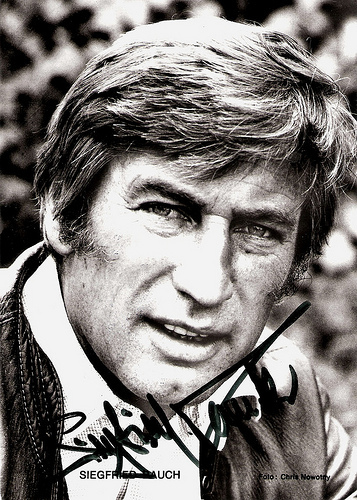
German postcard by Franz Josef Rüdel, Filmpostkartenverlag, Hamburg. Photo: Chris Nowotny, München.
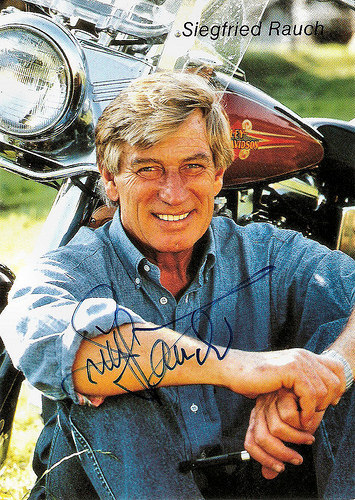
German promotion card by Süd Golf, Wolfratshausen.
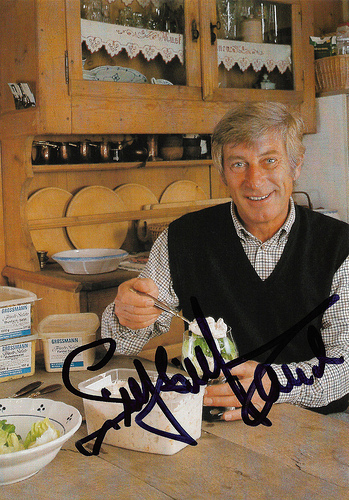
German autograph card by Firma Grossmann, Reinbek bei Hamburg.
Steve McQueen's rival
Siegfried Rauch was born in Landsberg am Lech, Germany, in 1932. Rauch studied drama at the Ludwig Maximilian University of Munich. Additionally, he attended private drama lessons. Since 1958, he has performed at different theatres, beginning with Bremen (until 1962), and followed by Berlin, Munich and Hamburg.
In 1956, he started his film career in the Heimatfilms Die Geierwally/Vulture Wally (Frantisek Cáp, 1956), starring Barbara Rütting and Carl Möhner , and Der Jäger von Fall/The Hunter of Fall (Gustav Ucicky, 1956), featuring Rudolf Lenz.
During the 1960s, he appeared in European coproductions like the Eurospy film Kommissar X - Drei gelbe Katzen/Death is Nimble, Death is Quick (Rudolf Zehetgruber, Gianfranco Parolini, 1966), starring Tony Kendall and Brad Harris . It is the second of seven films, loosely based on the Kommissar X #73 detective novel from the Pabel Moewig publishing house.
Another Eurospy film in which he played a supporting part was Mister Dynamit - Morgen küßt euch der Tod/Spy Today, Die Tomorrow (Franz Josef Gottlieb, 1967) starring Lex Barker and Maria Perschy . Rauch also appeared in the thriller Im Banne des Unheimlichen/The Zombie Walks (Alfred Vohrer, 1968) starring Joachim Fuchsberger . It is part of the series of German screen adaptations of Edgar Wallace's thriller novels.
In the 1970s Rauch often worked in Hollywood. He appeared opposite George C. Scott in the war epic Patton (Franklin J. Schaffner, 1970) as Captain Steiger. The film won seven Oscars, including Best Picture. In Le Mans (Lee H. Katzin, 1971), Rauch played the race driver Erich Stahler who is Steve McQueen's rival. Other Hollywood productions in which Rauch appeared were the war film The Eagle Has Landed (John Sturges, 1976) with Michael Caine , and Escape to Athena (George P. Cosmatos, 1979), starring Roger Moore and David Niven .
In Samuel Fuller's World War II war film The Big Red One (1980), Rauch played a German army sergeant, the opposite of Lee Marvin's character, who experiences the same events as Marvin only from a German perspective.
Mark Deming at AllMovie : “Unfortunately, Fuller was forced by his producers to work with a scaled-down budget, and he did not have final cut on the film; after his first rough cut ran nearly four-and-a-half hours, the studio took over editing on the project, and Fuller was vocally unhappy with the final results. In 2003, critic and film historian Richard Schickel initiated an effort to restore The Big Red One to a form that more closely resembled Fuller's original vision.“
Schickel's reconstruction received enthusiastic reviews when it went into limited release in the fall of 2004.
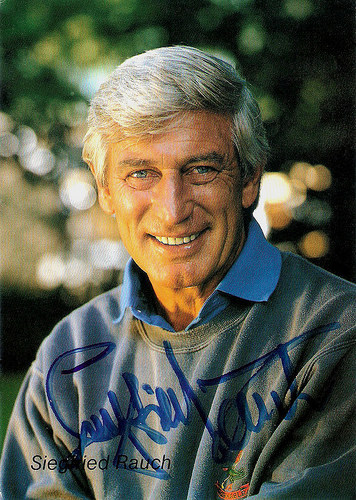
German autograph card.
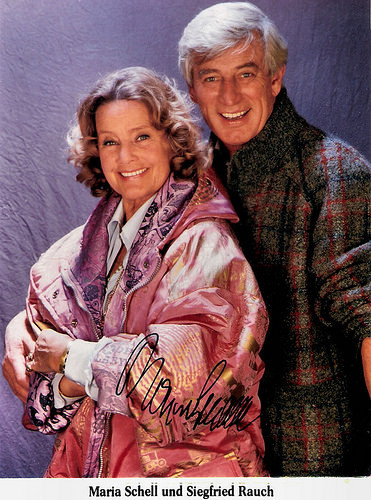
German autograph card. Publicity still for the TV series Die glückliche Familie/The Happy Family (1987-1991) with Maria Schell .
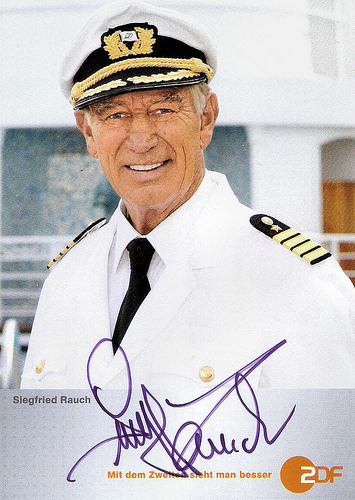
German autograph card by 2DF. Photo: ZDF / Dirk Bartling. Publicity still for the TV series Das Traumschiff/The Dream Boat (1997-2013).
It Can't Always Be Caviar
Siegfried Rauch continued to work in the German cinema and also on TV. He played in a new version of the Heimatfilm Der Jäger von Fall/The Hunter of Fall (Harald Reinl, 1974).
His most famous leading act on German television was Thomas Lieven in the mini-series Es muss nicht immer Kaviar sein/It Can't Always Be Caviar (Thomas Engel, 1977), based on the international bestseller by Johannes Mario Simmel. The series is unique for providing a little cooking show at the end of each episode. The book also includes recipes because Thomas Lieven is an accomplished amateur cook. The 13 episodes were very popular in Germany during the 1970s and 1980s, and have since attained cult-status.
Rauch’s various other roles on television established his career as an actor in Germany. Since 1997, Rauch has continuously appeared in Das Traumschiff/The Dreamboat (1997-2013), one of the most-watched television series in Germany. He also appeared in other long-running hit-series like Die Landärztin/The Country Doctor (2006-2011), the Das Traumschiff spin-off Kreuzfahrt ins Glück/Cruise to Happiness (2007-2013) and Der Bergdoktor/Mountain Medic (2008-2016, 96 episodes).
Internationally he appeared in films like the science fiction-horror film Contamination (Luigi Cozzi, 1980) starring Ian McCulloch, the action film Der Stein des Todes/Perahera, Death Stone (Franz Josef Gottlieb, 1985) and another actioner Feuer, Eis und Dynamit/Fire, Ice and Dynamite (Willy Bogner, 1990), starring Roger Moore .
Siegfried Rauch, also known as ‘Sigi’, died in 2018 as a result of a fall in his hometown of Untersochering, Bavaria. He was married to Karin and had two sons, Jakob and Benedikt, and one grandchild. Steve McQueen was the Godfather of his son Jakob.
Trailer Kommissar X - Drei gelbe Katzen/Death is Nimble, Death is Quick (1966). Source: Italo-Cinema Trailer (YouTube).
Trailer for Mister Dynamit - Morgen küßt euch der Tod/Spy Today, Die Tomorrow (1967). Source: Italo-Cinema Trailer (YouTube).
Trailer Le Mans (1971). Source: Umbrella Entertainment (YouTube).
Trailer The Big Red One (1980). Source: Video Detective (YouTube).
Sources: Mark Deming (AllMovie), Wikipedia (English and German), and .

German postcard by Franz Josef Rüdel, Filmpostkartenverlag, Hamburg. Photo: Chris Nowotny, München.

German promotion card by Süd Golf, Wolfratshausen.

German autograph card by Firma Grossmann, Reinbek bei Hamburg.
Steve McQueen's rival
Siegfried Rauch was born in Landsberg am Lech, Germany, in 1932. Rauch studied drama at the Ludwig Maximilian University of Munich. Additionally, he attended private drama lessons. Since 1958, he has performed at different theatres, beginning with Bremen (until 1962), and followed by Berlin, Munich and Hamburg.
In 1956, he started his film career in the Heimatfilms Die Geierwally/Vulture Wally (Frantisek Cáp, 1956), starring Barbara Rütting and Carl Möhner , and Der Jäger von Fall/The Hunter of Fall (Gustav Ucicky, 1956), featuring Rudolf Lenz.
During the 1960s, he appeared in European coproductions like the Eurospy film Kommissar X - Drei gelbe Katzen/Death is Nimble, Death is Quick (Rudolf Zehetgruber, Gianfranco Parolini, 1966), starring Tony Kendall and Brad Harris . It is the second of seven films, loosely based on the Kommissar X #73 detective novel from the Pabel Moewig publishing house.
Another Eurospy film in which he played a supporting part was Mister Dynamit - Morgen küßt euch der Tod/Spy Today, Die Tomorrow (Franz Josef Gottlieb, 1967) starring Lex Barker and Maria Perschy . Rauch also appeared in the thriller Im Banne des Unheimlichen/The Zombie Walks (Alfred Vohrer, 1968) starring Joachim Fuchsberger . It is part of the series of German screen adaptations of Edgar Wallace's thriller novels.
In the 1970s Rauch often worked in Hollywood. He appeared opposite George C. Scott in the war epic Patton (Franklin J. Schaffner, 1970) as Captain Steiger. The film won seven Oscars, including Best Picture. In Le Mans (Lee H. Katzin, 1971), Rauch played the race driver Erich Stahler who is Steve McQueen's rival. Other Hollywood productions in which Rauch appeared were the war film The Eagle Has Landed (John Sturges, 1976) with Michael Caine , and Escape to Athena (George P. Cosmatos, 1979), starring Roger Moore and David Niven .
In Samuel Fuller's World War II war film The Big Red One (1980), Rauch played a German army sergeant, the opposite of Lee Marvin's character, who experiences the same events as Marvin only from a German perspective.
Mark Deming at AllMovie : “Unfortunately, Fuller was forced by his producers to work with a scaled-down budget, and he did not have final cut on the film; after his first rough cut ran nearly four-and-a-half hours, the studio took over editing on the project, and Fuller was vocally unhappy with the final results. In 2003, critic and film historian Richard Schickel initiated an effort to restore The Big Red One to a form that more closely resembled Fuller's original vision.“
Schickel's reconstruction received enthusiastic reviews when it went into limited release in the fall of 2004.

German autograph card.

German autograph card. Publicity still for the TV series Die glückliche Familie/The Happy Family (1987-1991) with Maria Schell .

German autograph card by 2DF. Photo: ZDF / Dirk Bartling. Publicity still for the TV series Das Traumschiff/The Dream Boat (1997-2013).
It Can't Always Be Caviar
Siegfried Rauch continued to work in the German cinema and also on TV. He played in a new version of the Heimatfilm Der Jäger von Fall/The Hunter of Fall (Harald Reinl, 1974).
His most famous leading act on German television was Thomas Lieven in the mini-series Es muss nicht immer Kaviar sein/It Can't Always Be Caviar (Thomas Engel, 1977), based on the international bestseller by Johannes Mario Simmel. The series is unique for providing a little cooking show at the end of each episode. The book also includes recipes because Thomas Lieven is an accomplished amateur cook. The 13 episodes were very popular in Germany during the 1970s and 1980s, and have since attained cult-status.
Rauch’s various other roles on television established his career as an actor in Germany. Since 1997, Rauch has continuously appeared in Das Traumschiff/The Dreamboat (1997-2013), one of the most-watched television series in Germany. He also appeared in other long-running hit-series like Die Landärztin/The Country Doctor (2006-2011), the Das Traumschiff spin-off Kreuzfahrt ins Glück/Cruise to Happiness (2007-2013) and Der Bergdoktor/Mountain Medic (2008-2016, 96 episodes).
Internationally he appeared in films like the science fiction-horror film Contamination (Luigi Cozzi, 1980) starring Ian McCulloch, the action film Der Stein des Todes/Perahera, Death Stone (Franz Josef Gottlieb, 1985) and another actioner Feuer, Eis und Dynamit/Fire, Ice and Dynamite (Willy Bogner, 1990), starring Roger Moore .
Siegfried Rauch, also known as ‘Sigi’, died in 2018 as a result of a fall in his hometown of Untersochering, Bavaria. He was married to Karin and had two sons, Jakob and Benedikt, and one grandchild. Steve McQueen was the Godfather of his son Jakob.
Trailer Kommissar X - Drei gelbe Katzen/Death is Nimble, Death is Quick (1966). Source: Italo-Cinema Trailer (YouTube).
Trailer for Mister Dynamit - Morgen küßt euch der Tod/Spy Today, Die Tomorrow (1967). Source: Italo-Cinema Trailer (YouTube).
Trailer Le Mans (1971). Source: Umbrella Entertainment (YouTube).
Trailer The Big Red One (1980). Source: Video Detective (YouTube).
Sources: Mark Deming (AllMovie), Wikipedia (English and German), and .
Published on March 14, 2018 23:00
March 13, 2018
Eine Nacht in der Stahlkammer (1917)
The German silent cinema knew many popular detective films like the Joe Deebs serial or the Sherlock Holmes adaptations. Another example is Eine Nacht in der Stahlkammer/A Night in the Steel Chamber (Felix Basch, 1917) with Leopoldine Konstantin, Harry Liedtke, Gertrude Welcker and Heinrich Peer as the sleuth Harry Reep.

German postcard by Photochemie, Berlin, no. K. 2023. Photo: Union Film. Publicity still for Eine Nacht in der Stahlkammer/A Night in the Steel Chamber (Felix Basch, 1917) with Harry Liedtke and Leopoldine Konstantin .

German postcard by Photochemie, Berlin, no. K. 2024. Photo: Union Film. Heinrich Peer in Eine Nacht in der Stahlkammer/A Night in the Steel Chamber (Felix Basch, 1917).

German postcard by Photochemie, Berlin, no. K. 2025. Photo: Union Film. Publicity still for Eine Nacht in der Stahlkammer/A Night in the Steel Chamber (Felix Basch, 1917) with Heinrich Peer .
Stolen money in a secret drawer
The plot of Eine Nacht in der Stahlkammer/A Night in the Steel Chamber (Felix Basch, 1917) deals with bank director Kendall ( Harry Liedtke ). To satisfy the needs of his girlfriend, the art maecenas and performer Celestine ( Leopoldine Konstantin ), Kendall steals from his bank's safe money which his father-in-law had invested in his business.
The known detective Harry Reep (Heinrich Peer) is hired to investigate the theft. When the banker's wife's brother lends another big sum to keep the bank going, this sum is stolen too. Harry, disguised as bank manager, is suspected himself but then finds Kendall shot.
Harry later drives with the empty bank cassette in his car but is held up by Celestine who with a trick steals the empty cassette. Reep pursues Celestine by car but she manages to escape.
Later in the theatre where Celestine performs, he fights and conquers her. He discovers the cassette had a secret drawer and is filled with the stolen money. Celestine kills herself and Reep finds a suicide letter by Kendall, who committed suicide out of remorse.
Eine Nacht in der Stahlkammer was shot mid-1917 and shown in Austria from August 1917. German censorship forbid the film for the duration of the war, so it was released there from late 1918 onwards.
"Not only does this film work have an interesting criminal theme as subject, the technique is brilliant, state-of-the-art, and the acting is exemplary. Rarely does one find such a perfectly harmonious interplay as is the case in this picture. Harry Liedtke , a reckless man who becomes a criminal, is as excellent as Heinrich Peer as the detective. A special attraction, however, is the well-known actress Leopoldine Konstantin ... In addition to all these advantages, it should be mentioned that a eye keen on sensation also gets his money's worth." (Neu Kino-Rundschau, 25 August 1917)

German postcard by Photochemie, Berlin, no. K. 2026. Photo: Union Film. Publicity still for Eine Nacht in der Stahlkammer/A Night in the Steel Chamber (Felix Basch, 1917) with Harry Liedtke .
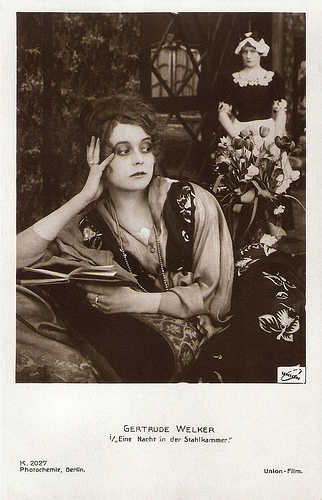
German postcard by Photochemie, Berlin, no. K. 2027. Photo: Union Film. Publicity still for Eine Nacht in der Stahlkammer/A Night in the Steel Chamber (Felix Basch, 1917) with Gertrude Welcker (on the postcard written as Gertrude Welker).

Heinrich Peer . German postcard by Verlag Hermann Leiser, Berlin. no. 5296. Photo: Alex Binder, Berlin, 1916.
Source: Wikipedia (German).

German postcard by Photochemie, Berlin, no. K. 2023. Photo: Union Film. Publicity still for Eine Nacht in der Stahlkammer/A Night in the Steel Chamber (Felix Basch, 1917) with Harry Liedtke and Leopoldine Konstantin .

German postcard by Photochemie, Berlin, no. K. 2024. Photo: Union Film. Heinrich Peer in Eine Nacht in der Stahlkammer/A Night in the Steel Chamber (Felix Basch, 1917).

German postcard by Photochemie, Berlin, no. K. 2025. Photo: Union Film. Publicity still for Eine Nacht in der Stahlkammer/A Night in the Steel Chamber (Felix Basch, 1917) with Heinrich Peer .
Stolen money in a secret drawer
The plot of Eine Nacht in der Stahlkammer/A Night in the Steel Chamber (Felix Basch, 1917) deals with bank director Kendall ( Harry Liedtke ). To satisfy the needs of his girlfriend, the art maecenas and performer Celestine ( Leopoldine Konstantin ), Kendall steals from his bank's safe money which his father-in-law had invested in his business.
The known detective Harry Reep (Heinrich Peer) is hired to investigate the theft. When the banker's wife's brother lends another big sum to keep the bank going, this sum is stolen too. Harry, disguised as bank manager, is suspected himself but then finds Kendall shot.
Harry later drives with the empty bank cassette in his car but is held up by Celestine who with a trick steals the empty cassette. Reep pursues Celestine by car but she manages to escape.
Later in the theatre where Celestine performs, he fights and conquers her. He discovers the cassette had a secret drawer and is filled with the stolen money. Celestine kills herself and Reep finds a suicide letter by Kendall, who committed suicide out of remorse.
Eine Nacht in der Stahlkammer was shot mid-1917 and shown in Austria from August 1917. German censorship forbid the film for the duration of the war, so it was released there from late 1918 onwards.
"Not only does this film work have an interesting criminal theme as subject, the technique is brilliant, state-of-the-art, and the acting is exemplary. Rarely does one find such a perfectly harmonious interplay as is the case in this picture. Harry Liedtke , a reckless man who becomes a criminal, is as excellent as Heinrich Peer as the detective. A special attraction, however, is the well-known actress Leopoldine Konstantin ... In addition to all these advantages, it should be mentioned that a eye keen on sensation also gets his money's worth." (Neu Kino-Rundschau, 25 August 1917)

German postcard by Photochemie, Berlin, no. K. 2026. Photo: Union Film. Publicity still for Eine Nacht in der Stahlkammer/A Night in the Steel Chamber (Felix Basch, 1917) with Harry Liedtke .

German postcard by Photochemie, Berlin, no. K. 2027. Photo: Union Film. Publicity still for Eine Nacht in der Stahlkammer/A Night in the Steel Chamber (Felix Basch, 1917) with Gertrude Welcker (on the postcard written as Gertrude Welker).

Heinrich Peer . German postcard by Verlag Hermann Leiser, Berlin. no. 5296. Photo: Alex Binder, Berlin, 1916.
Source: Wikipedia (German).
Published on March 13, 2018 23:00
March 12, 2018
Jane Birkin
In the Swinging Sixties, shy, awkward-looking British actress Jane Birkin (1946) made a huge international splash as one of the nude models in Antonioni's Blow-Up (1966). In France she became the muse of singer-songwriter Serge Gainsbourg, who wrote several of her albums, plus their explicitly erotic duet Je t'aime... moi non plus. Later she worked with such respected film directors as Jacques Rivette, Agnès Varda and Jacques Doillon, and won several acting awards.

French postcard by V, Paris, no. 95022. Photo: Bernard Leloup / Salut. Promotion card for the Fontana album Ex fan des sixties.
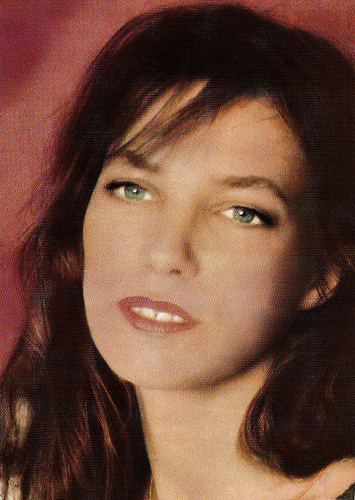
Romanian postcard by Casa Filmului Acin, no. 33102.
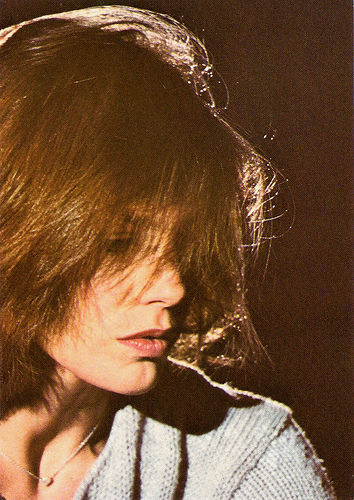
French postcard. Photo: Phonogram/Raymond Bounon. Publicity still for the record Baby alone in Baylone (1983).
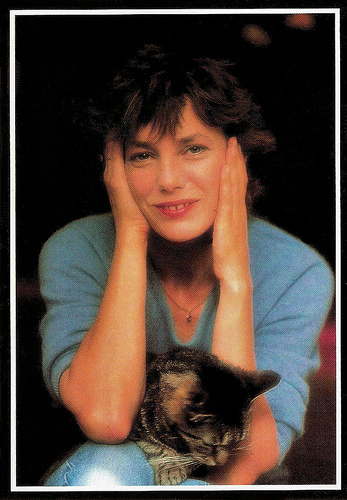
French postcard by Éditions Damilla, Paris, no. 95022. Photo: R. Melloul / SYGMA.
A mythical and passionate Paris love story
Jane Mallory Birkin was born in London in 1946. Her mother, Judy Campbell, was an English stage actress, and her father, David Birkin, was a Royal Navy lieutenant-commander, who had worked on clandestine operations as navigator with the French Resistance. Her brother is the screenwriter and director Andrew Birkin. She was educated at Upper Chine School, Isle of Wight, and then went to Kensington Academy in London.
At 17, she first went on stage in Graham Greene's 1964 production Carving a Statue. A year later she was chosen to play in the musical comedy Passion Flower Hotel with music by John Barry (composer of the James Bond theme). They met and married shortly afterwards. Their daughter Kate Barry, now a photographer, was born in 1967.
Jane emerged in the Swinging London scene of the 1960s. First she appeared uncredited as a girl on a motorbike in the comedy The Knack …and How to Get It (Richard Lester, 1965) starring Rita Tushingham. Then she attracted attention with a brief scene as a nude, blonde model in Blowup (1966), Michelangelo Antonioni's scandalous masterpiece that received the Palme d'or award at the Cannes Film Festival.
In 1968, Birkin played a fantasy-like model in the psychedelic picture Wonderwall (Joe Massot, 1968). That same year, she auditioned in France for the lead female role in Slogan (Pierre Grimblat, 1969) with pop star Serge Gainsbourg , who was still grieving after his break up with Brigitte Bardot . Jane barely spoke French, and Gainsbourg gave her a rough time. When she burst into tears, mixing private sadness about John Barry and the film part, he disapproved, but he recognised that she cried well in front of the camera. Jane got the part, and a mythical and passionate Paris love story began.
Birkin performed with Gainsbourg on the film's theme song, La chanson de slogan — the first of many collaborations between the two. They became inseparable and a living legend when they recorded the duet Je t'aime... moi non plus (I love you... me neither), a song Gainsbourg originally had written for Brigitte Bardot . The song's fame is partly a result of its salacious lyrics, sung by Gainsbourg and Birkin to a background of passionate whispering and moaning from Birkin, concluding in her simulated orgasm. Censorship in several countries went wild, the Vatican condemned the immoral nature of the song, and in Great Britain the BBC refused to play the original, and did their own orchestral version. The record benefited from all the free publicity and rocketed straight to the top of the charts, selling a million copies in a matter of months.
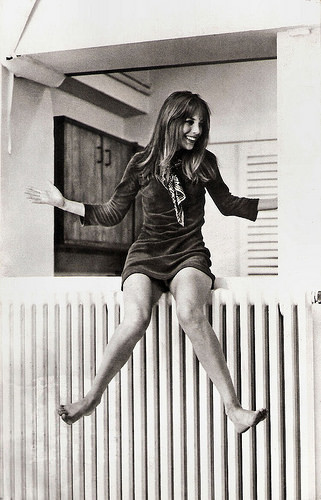
Romanian postcard by Casa Filmului Acin, no. 448. Photo: publicity still for Slogan (Pierre Grimblat, 1969).
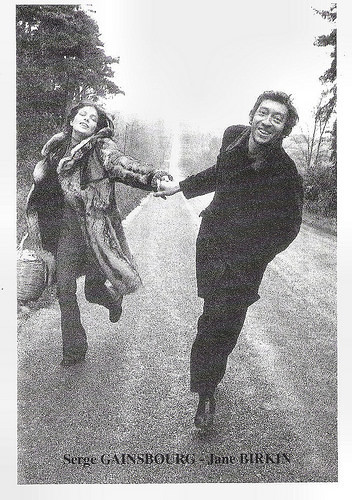
French card. With Serge Gainsbourg .
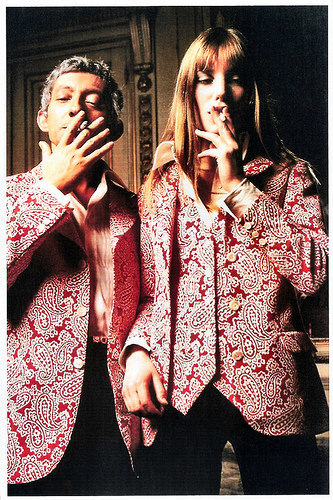
French autograph card. With Serge Gainsbourg .

French postcard by Éditions Damilla, Paris, no. 95023. Photo: Dominique Issermann / SYGMA.
Cute But Stupid
At the Côte d'Azur, Jane Birkin played in the thriller La Piscine/The Swimming Pool (Jacques Deray, 1969) in which she was seduced by Alain Delon . Then she went with Serge Gainsbourg to Yugoslavia to play in the adventure film Romansa konjokradice/Romance of a horse thief (Abraham Polonsky, 1971) starring Yul Brynner.
In 1971 her daughter, the actress and singer Charlotte Gainsbourg was born. Birkin took a break from acting, but returned as the lover of Brigitte Bardot (in her final film role) in Don Juan ou Si Don Juan était une femme.../Don Juan 73 (Roger Vadim, 1973). Her first solo album, Di Doo Dah, was also released in 1973. The title song became another chart hit.
In the cinema Birkin played 'cute but stupid' roles in box office hits as La moutarde me monte au nez/Lucky Pierre (Claude Zidi, 1974) and La course à l’échalotte/The Wild Goose Chase (Claude Zidi, 1975), two popular comedies starring Pierre Richard . She proved herself as a film actress in Le Mouton enragé/Love at the Top (Michel Deville, 1974) starring Romy Schneider , and the highly dramatic Sept morts sur ordonnance/Seven Deaths by Prescription (Jacques Rouffio, 1975) opposite Michel Piccoli .
In 1975, she also appeared with Joe Dallesandro in Gainsbourg's daring directorial début Je t'aime... moi non plus (Serge Gainsbourg, 1976). The film created a stir for its frank examination of sexual ambiguity and the controversial sex scenes. For her performance as an androgynous looking teenager she was nominated for a Best Actress César Award.
In the meantime, her second album Lolita go home (1975) came out, on which she sang Philippe Labro's lyrics set to Gainsbourg's music. Three years later, her Ex-fan des sixties (1978) was released.
Birkin starred in a series of mainstream films such as L'Animal/Stuntwoman (Claude Zidi, 1977) with Jean-Paul Belmondo , and the Agatha Christie films Death on the Nile (John Guillermin, 1978) and Evil Under the Sun (Guy Hamilton, 1982), with Peter Ustinov as Belgian detective Hercule Poirot. In the arthouse production Egon Schiele Exzess und Bestrafung/Egon Schiele: Excess and Punishment (Herbert Vesely, 1980), she appeared as the mistress of Austrian artist Egon Schiele, played by Mathieu Carrière .
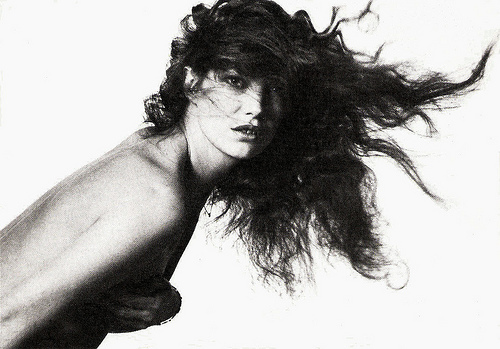
French postcard by Ëditions du Désastre, Boulogne, no. PK 2, 1982. Photo: Peter Knapp, 1980.
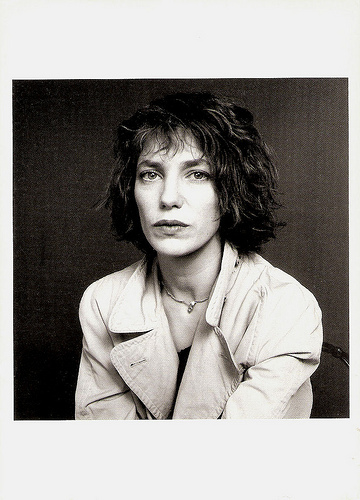
Swiss postcard by Musée de l'Elysée/News Productions, Baulmes, no. 55594. Photo: Laurence Sudre.
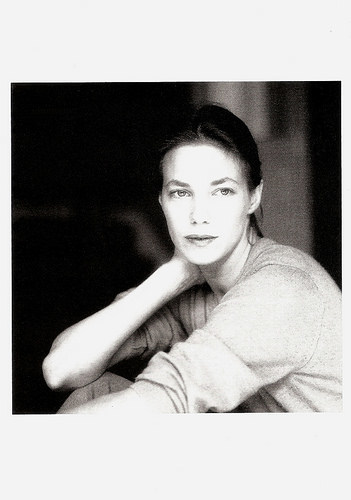
French postcard by Editions Marion-Valentine, Paris, no. N-177. Photo: Dominique Issermann. Caption: Jane Birkin 1981.
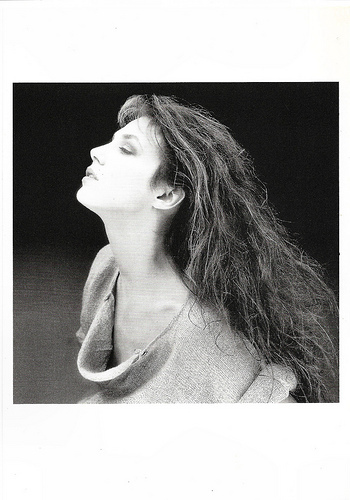
French postcard by Editions Marion-Valentine, Paris, no. N-176. Photo: Dominique Issermann. Caption: Jane Birkin 1983.
The Very Best of Her
Serge Gainsbourg had plunged into several major bouts of alcoholism and depression, resulting in all-night partying and scandals, and in 1980 Jane Birkin left him. The couple remained on good terms though. Birkin starred as Anne in La fille prodigue/The Prodigal Daughter (Jacques Doillon, 1981).
Jacques Doillon proved to be her dream of a director, who imposed his own personal style of drama, and brought out the very best of her. She went to live with him, and in 1982 she had her third daughter Lou Doillon. She also appeared as Alma opposite Maruschka Detmers in his La pirate/The Pirate (Jacques Doillon, 1984), for which she was nominated for a César Award.
This work led to an invitation from theatre director Patrice Chéreau to star on stage in La Fausse suivante (The False Servant) by Pierre de Marivaux. Gainsbourg, suffering from the separation, wrote Baby alone in Babylone for her. The record won the Charles Cross award and became a gold record. She began to appear frequently on stage in plays and concerts in France, Japan, the U.K. and then the U.S.
Film director Jacques Rivette collaborated with her in L'amour par terre/Love on the Ground (Jacques Rivette, 1983) starring Geraldine Chaplin , and La Belle Noiseuse/The Beautiful Troublemaker (Jacques Rivette, 1991) with Michel Piccoli and Emmanuelle Béart . Again Birkin was nominated for the César for best supporting actress, for both films.
She created a sensation as star and screenwriter of director Agnès Varda's Kung Fu Master (1987), in which she played a 40-year-old woman carrying on a torrid affair with a 15-year-old boy, played by Mathieu Demy, Varda's son. The following year, Varda expressed her admiration for Birkin with the feature-length documentary Jane B. par Agnes V (Agnès Varda, 1988).
Birkin’s work in Dust (Marion Hänsel, 1985) with Trevor Howard , and Daddy Nostalgie (Bertrand Tavernier, 1990) opposite Dirk Bogarde also earned her the praise and respect of international critics. Additionally, she appeared in Merchant Ivory's A Soldier's Daughter Never Cries (James Ivory, 1998) and Merci Docteur Rey (Andrew Litvack, 2002) with Dianne Wiest, while the end title song of Le Divorce (James Ivory, 2003) featured her singing L'Anamour, composed by Serge Gainsbourg.
In 1990 Serge Gainsbourg dedicated a new album to her: Amours des feintes. It was to be his last. He died in 1991. A year later Birkin won the Female Artist of the Year award at the 1992 Victoires de la Musique. In 1993 she separated from Jacques Doillon. In the following years she devoted herself to her family and to her humanitarian work with Amnesty International on immigrant welfare and AIDS issues. Birkin visited Bosnia, Rwanda and Palestine, often working with children.
In 2001, she was awarded the OBE in Great Britain. She has also been awarded the French Ordre national du Mérite in 2004. Jane Birkin continues to make films, theatre and music. She collaborated with such artists as Bryan Ferry, Manu Chao, Françoise Hardy , Rufus Wainwright, and Les Negresses Vertes on albums as Rendez-Vous (2004) and Fictions (2006). The self-penned Enfants d'Hiver arrived in 2008.
In 2006, Birkin played the title role in Elektra, directed by Philippe Calvario in France. At the Cannes Film Festival 2007, she presented a film, both as a director and actor: Boxes (2007) with Michel Piccoli , Geraldine Chaplin , and her daughter Lou Doillon.
She also appeared in Si tu meurs, je te tue/If you die, I’ll kill you (Hiner Saleem, 2011) with Jonathan Zaccaï, and La femme et le TGV/The Railroad Lady (2016), a short film directed by Swiss filmmaker Timo von Gunten. The film was nominated for an Academy Award for Best Live Action Short Film. In a 2017 interview, Birkin stated that La femme et le TGV would be her final acting performance, and that she had no plans to return to acting.
In March 2017, Jane Birkin released Birkin/Gainsbourg: Le Symphonique, a collection of songs Serge Gainsbourg had written for her during and after their relationship, reworked with full orchestral arrangements.
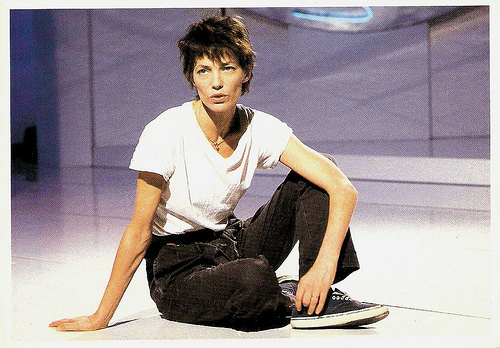
French postcard, no. C 4477.
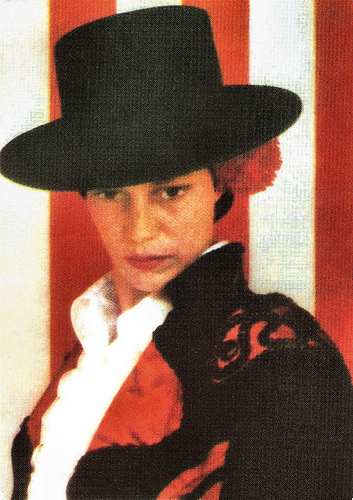
Romanian postcard by Casa Filmului Acin. Photo: publicity still for Jane. B par Agnes V. (Agnes Varda, 1987).
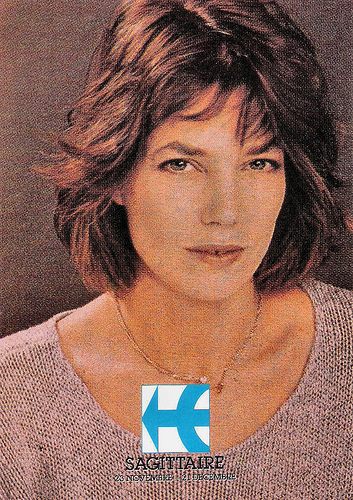
French postcard in the Signes du Zodiaque series by Editions F. Nugeron, no. 13 - Sagittaire (Sagittarius).
Trailer Wonderwall (1968). Source: Our Man in Havana (YouTube).
Trailer Slogan (1969). Source: 7173Productions (YouTube).
Jane Birkin sings Quoi (1995). Source: bcbauer (YouTube).
Sources: Hal Erickson (AllMovie), John Bush (AllMusic), RFI Musique, Wikipedia, and .

French postcard by V, Paris, no. 95022. Photo: Bernard Leloup / Salut. Promotion card for the Fontana album Ex fan des sixties.

Romanian postcard by Casa Filmului Acin, no. 33102.

French postcard. Photo: Phonogram/Raymond Bounon. Publicity still for the record Baby alone in Baylone (1983).

French postcard by Éditions Damilla, Paris, no. 95022. Photo: R. Melloul / SYGMA.
A mythical and passionate Paris love story
Jane Mallory Birkin was born in London in 1946. Her mother, Judy Campbell, was an English stage actress, and her father, David Birkin, was a Royal Navy lieutenant-commander, who had worked on clandestine operations as navigator with the French Resistance. Her brother is the screenwriter and director Andrew Birkin. She was educated at Upper Chine School, Isle of Wight, and then went to Kensington Academy in London.
At 17, she first went on stage in Graham Greene's 1964 production Carving a Statue. A year later she was chosen to play in the musical comedy Passion Flower Hotel with music by John Barry (composer of the James Bond theme). They met and married shortly afterwards. Their daughter Kate Barry, now a photographer, was born in 1967.
Jane emerged in the Swinging London scene of the 1960s. First she appeared uncredited as a girl on a motorbike in the comedy The Knack …and How to Get It (Richard Lester, 1965) starring Rita Tushingham. Then she attracted attention with a brief scene as a nude, blonde model in Blowup (1966), Michelangelo Antonioni's scandalous masterpiece that received the Palme d'or award at the Cannes Film Festival.
In 1968, Birkin played a fantasy-like model in the psychedelic picture Wonderwall (Joe Massot, 1968). That same year, she auditioned in France for the lead female role in Slogan (Pierre Grimblat, 1969) with pop star Serge Gainsbourg , who was still grieving after his break up with Brigitte Bardot . Jane barely spoke French, and Gainsbourg gave her a rough time. When she burst into tears, mixing private sadness about John Barry and the film part, he disapproved, but he recognised that she cried well in front of the camera. Jane got the part, and a mythical and passionate Paris love story began.
Birkin performed with Gainsbourg on the film's theme song, La chanson de slogan — the first of many collaborations between the two. They became inseparable and a living legend when they recorded the duet Je t'aime... moi non plus (I love you... me neither), a song Gainsbourg originally had written for Brigitte Bardot . The song's fame is partly a result of its salacious lyrics, sung by Gainsbourg and Birkin to a background of passionate whispering and moaning from Birkin, concluding in her simulated orgasm. Censorship in several countries went wild, the Vatican condemned the immoral nature of the song, and in Great Britain the BBC refused to play the original, and did their own orchestral version. The record benefited from all the free publicity and rocketed straight to the top of the charts, selling a million copies in a matter of months.

Romanian postcard by Casa Filmului Acin, no. 448. Photo: publicity still for Slogan (Pierre Grimblat, 1969).

French card. With Serge Gainsbourg .

French autograph card. With Serge Gainsbourg .

French postcard by Éditions Damilla, Paris, no. 95023. Photo: Dominique Issermann / SYGMA.
Cute But Stupid
At the Côte d'Azur, Jane Birkin played in the thriller La Piscine/The Swimming Pool (Jacques Deray, 1969) in which she was seduced by Alain Delon . Then she went with Serge Gainsbourg to Yugoslavia to play in the adventure film Romansa konjokradice/Romance of a horse thief (Abraham Polonsky, 1971) starring Yul Brynner.
In 1971 her daughter, the actress and singer Charlotte Gainsbourg was born. Birkin took a break from acting, but returned as the lover of Brigitte Bardot (in her final film role) in Don Juan ou Si Don Juan était une femme.../Don Juan 73 (Roger Vadim, 1973). Her first solo album, Di Doo Dah, was also released in 1973. The title song became another chart hit.
In the cinema Birkin played 'cute but stupid' roles in box office hits as La moutarde me monte au nez/Lucky Pierre (Claude Zidi, 1974) and La course à l’échalotte/The Wild Goose Chase (Claude Zidi, 1975), two popular comedies starring Pierre Richard . She proved herself as a film actress in Le Mouton enragé/Love at the Top (Michel Deville, 1974) starring Romy Schneider , and the highly dramatic Sept morts sur ordonnance/Seven Deaths by Prescription (Jacques Rouffio, 1975) opposite Michel Piccoli .
In 1975, she also appeared with Joe Dallesandro in Gainsbourg's daring directorial début Je t'aime... moi non plus (Serge Gainsbourg, 1976). The film created a stir for its frank examination of sexual ambiguity and the controversial sex scenes. For her performance as an androgynous looking teenager she was nominated for a Best Actress César Award.
In the meantime, her second album Lolita go home (1975) came out, on which she sang Philippe Labro's lyrics set to Gainsbourg's music. Three years later, her Ex-fan des sixties (1978) was released.
Birkin starred in a series of mainstream films such as L'Animal/Stuntwoman (Claude Zidi, 1977) with Jean-Paul Belmondo , and the Agatha Christie films Death on the Nile (John Guillermin, 1978) and Evil Under the Sun (Guy Hamilton, 1982), with Peter Ustinov as Belgian detective Hercule Poirot. In the arthouse production Egon Schiele Exzess und Bestrafung/Egon Schiele: Excess and Punishment (Herbert Vesely, 1980), she appeared as the mistress of Austrian artist Egon Schiele, played by Mathieu Carrière .

French postcard by Ëditions du Désastre, Boulogne, no. PK 2, 1982. Photo: Peter Knapp, 1980.

Swiss postcard by Musée de l'Elysée/News Productions, Baulmes, no. 55594. Photo: Laurence Sudre.

French postcard by Editions Marion-Valentine, Paris, no. N-177. Photo: Dominique Issermann. Caption: Jane Birkin 1981.

French postcard by Editions Marion-Valentine, Paris, no. N-176. Photo: Dominique Issermann. Caption: Jane Birkin 1983.
The Very Best of Her
Serge Gainsbourg had plunged into several major bouts of alcoholism and depression, resulting in all-night partying and scandals, and in 1980 Jane Birkin left him. The couple remained on good terms though. Birkin starred as Anne in La fille prodigue/The Prodigal Daughter (Jacques Doillon, 1981).
Jacques Doillon proved to be her dream of a director, who imposed his own personal style of drama, and brought out the very best of her. She went to live with him, and in 1982 she had her third daughter Lou Doillon. She also appeared as Alma opposite Maruschka Detmers in his La pirate/The Pirate (Jacques Doillon, 1984), for which she was nominated for a César Award.
This work led to an invitation from theatre director Patrice Chéreau to star on stage in La Fausse suivante (The False Servant) by Pierre de Marivaux. Gainsbourg, suffering from the separation, wrote Baby alone in Babylone for her. The record won the Charles Cross award and became a gold record. She began to appear frequently on stage in plays and concerts in France, Japan, the U.K. and then the U.S.
Film director Jacques Rivette collaborated with her in L'amour par terre/Love on the Ground (Jacques Rivette, 1983) starring Geraldine Chaplin , and La Belle Noiseuse/The Beautiful Troublemaker (Jacques Rivette, 1991) with Michel Piccoli and Emmanuelle Béart . Again Birkin was nominated for the César for best supporting actress, for both films.
She created a sensation as star and screenwriter of director Agnès Varda's Kung Fu Master (1987), in which she played a 40-year-old woman carrying on a torrid affair with a 15-year-old boy, played by Mathieu Demy, Varda's son. The following year, Varda expressed her admiration for Birkin with the feature-length documentary Jane B. par Agnes V (Agnès Varda, 1988).
Birkin’s work in Dust (Marion Hänsel, 1985) with Trevor Howard , and Daddy Nostalgie (Bertrand Tavernier, 1990) opposite Dirk Bogarde also earned her the praise and respect of international critics. Additionally, she appeared in Merchant Ivory's A Soldier's Daughter Never Cries (James Ivory, 1998) and Merci Docteur Rey (Andrew Litvack, 2002) with Dianne Wiest, while the end title song of Le Divorce (James Ivory, 2003) featured her singing L'Anamour, composed by Serge Gainsbourg.
In 1990 Serge Gainsbourg dedicated a new album to her: Amours des feintes. It was to be his last. He died in 1991. A year later Birkin won the Female Artist of the Year award at the 1992 Victoires de la Musique. In 1993 she separated from Jacques Doillon. In the following years she devoted herself to her family and to her humanitarian work with Amnesty International on immigrant welfare and AIDS issues. Birkin visited Bosnia, Rwanda and Palestine, often working with children.
In 2001, she was awarded the OBE in Great Britain. She has also been awarded the French Ordre national du Mérite in 2004. Jane Birkin continues to make films, theatre and music. She collaborated with such artists as Bryan Ferry, Manu Chao, Françoise Hardy , Rufus Wainwright, and Les Negresses Vertes on albums as Rendez-Vous (2004) and Fictions (2006). The self-penned Enfants d'Hiver arrived in 2008.
In 2006, Birkin played the title role in Elektra, directed by Philippe Calvario in France. At the Cannes Film Festival 2007, she presented a film, both as a director and actor: Boxes (2007) with Michel Piccoli , Geraldine Chaplin , and her daughter Lou Doillon.
She also appeared in Si tu meurs, je te tue/If you die, I’ll kill you (Hiner Saleem, 2011) with Jonathan Zaccaï, and La femme et le TGV/The Railroad Lady (2016), a short film directed by Swiss filmmaker Timo von Gunten. The film was nominated for an Academy Award for Best Live Action Short Film. In a 2017 interview, Birkin stated that La femme et le TGV would be her final acting performance, and that she had no plans to return to acting.
In March 2017, Jane Birkin released Birkin/Gainsbourg: Le Symphonique, a collection of songs Serge Gainsbourg had written for her during and after their relationship, reworked with full orchestral arrangements.

French postcard, no. C 4477.

Romanian postcard by Casa Filmului Acin. Photo: publicity still for Jane. B par Agnes V. (Agnes Varda, 1987).

French postcard in the Signes du Zodiaque series by Editions F. Nugeron, no. 13 - Sagittaire (Sagittarius).
Trailer Wonderwall (1968). Source: Our Man in Havana (YouTube).
Trailer Slogan (1969). Source: 7173Productions (YouTube).
Jane Birkin sings Quoi (1995). Source: bcbauer (YouTube).
Sources: Hal Erickson (AllMovie), John Bush (AllMusic), RFI Musique, Wikipedia, and .
Published on March 12, 2018 23:00
March 11, 2018
Enrique Iglesias
Athletic and sexy Spanish singer Enrique Iglesias (1975) is widely regarded as the King of Latin Pop. He started his career in the mid-1990s and has since then sold over 159 million records worldwide, making him one of the best-selling Spanish artists ever. Iglesias also starred in the Western Once Upon a Time in Mexico (2003).

Vintage postcard, no. 9354. On the postcard his name is misspelled as Iglasias.

Vintage card.
With money from his nanny
Enrique Miguel Iglesias Preysler was born in Madrid, Spain, in 1975. He is the third and youngest child of Spanish singer Julio Iglesias and Filipina socialite and magazine journalist Isabel Preysler. He was raised with two older siblings: Chabeli and Julio Jr. One of his mother Preysler's aunts is actress Neile Adams, the first wife of American actor Steve McQueen.
His parents divorced in 1979. At first, Iglesias and his two siblings stayed with their mother, but in 1986, Iglesias' grandfather, Dr. Julio Iglesias Puga, was kidnapped by the armed Basque terrorist group ETA. For their safety, Enrique and his brother Julio were sent to live with their father in Miami. There, they were brought up mostly by the nanny, Elvira Olivares, to whom he later dedicated his first album. Enrique also lived in Belgrade, Yugoslavia, for one year with his mother.
At the age of 15, he secretly began writing music. He studied business administration at the University of Miami for a year before he dropped out to pursue a musical career. Iglesias did not want his father to know about his plans for a musical career and did not want his famous surname to help advance his career. He borrowed money from his nanny and he recorded a demo cassette tape which consisted of a Spanish song and two English songs. Approaching his father's former publicist, Fernán Martínez, the two promoted the songs under the stage name 'Enrique Martínez' with the back story of being an unknown singer from Guatemala.
The 18-years-old Iglesias was signed on to Fonovisa Records and travelled to Toronto to record his first album. In 1995, he released Enrique Iglesias, a collection of light rock ballads, including hits such as Si Tú Te Vas and Experiencia Religiosa. This album sold half a million copies in its first week, and sold over a million copies in the next three months. The album went on to win Iglesias a Grammy Award for Best Latin Pop Performance.
In 1995 he also appeared in a bit part in Robert Rodriguez's film Desperado (1995) with Antonio Banderas and Salma Hayek. In 1997, Iglesias' stardom continued to rise with the release of Vivir (To Live), which put him up with other English language music superstars in sales for that year. The album also included a cover version of the Yazoo song Only You, translated into Spanish as Solo en Tí. Three singles released from Vivir (Enamorado Por Primera Vez, Sólo en Ti and Miente) topped the charts in several Spanish-speaking countries.
Along with his father and Luis Miguel, Iglesias was nominated for an American Music Award in the first-ever awarded category of Favourite Latin Artist. His first concert tour, that summer, Iglesias, backed by sidemen for Elton John , Bruce Springsteen and Billy Joel, played to sold-out audiences in sixteen countries.
In 1998, Iglesias released his third album, Cosas del Amor (Things of Love). Taking a more mature musical direction, the album, aided by the popular singles Esperanza and Nunca Te Olvidaré, both of which topped the Latin singles chart, helped cement his status in the Latin music scene. He won an American Music Award in the category of Favourite Latin Artist against Ricky Martin and Chayanne.

Dutch postcard in the series Schoolcards by Boomerang, Amsterdam. Promotion card for the single Si Tu Te Vas of the album Enrique Ilglesias.

Vintage postcard, no. Art. 9143.
Strained relationship with his famous father
By 1999, Enrique Iglesias had begun a successful crossover career into the English language music market. Will Smith asked Iglesias to contribute to the soundtrack of his steampunk Western Wild Wild West (Barry Sonnenfeld, 1999). His contribution Bailamos was released as a single and became a number one hit in the US.
After weeks of negotiations, Iglesias signed a multi-album deal with Interscope. He recorded and released his first full CD in English, Enrique. It contained the song Rhythm Divine, a duet with Whitney Houston entitled Could I Have This Kiss Forever, and a cover of the Bruce Springsteen song Sad Eyes. In 2000, Iglesias performed at the Super Bowl XXXIV halftime show alongside Christina Aguilera, Phil Collins, and Toni Braxton. His single Be With You became Iglesias's second number one single on Billboard's Hot 100.
In 2000, Iglesias co-produced an off Broadway musical called Four Guys Named Jose and Una Mujer Named Maria . In the musical, four Americans of Latin heritage possess a common interest in music and meet and decide to put on a show. The show contained many references and allusions to classic and contemporary Latin and pop songs by the likes of Carmen Miranda, Selena, Ritchie Valens, Chayanne, Ricky Martin and Iglesias himself.
In 2001 Iglesias released his second English language album Escape. Where most of the Latin crossover acts of the previous year experienced some difficulty matching the record sales of their first English language albums, Iglesias actually went on to sell even more. The album's first single, Hero, became a number one hit in the United Kingdom, and in many other countries. The entire album was co-written by Iglesias. He capitalised on the album's success with his One-Night Stand World Tour consisting of fifty sold-out shows in sixteen countries.
In late 2001, Iglesias started dating tennis player Anna Kournikova. They reportedly split in October 2013 but have since reconciled. In 2002 Iglesias released a fourth Spanish-language album titled Quizás (Perhaps). A more polished musical production than his previous Spanish albums and containing more introspective songs, the album's title track is a song about the strained relationship Iglesias has with his famous father. The album debuted at number twelve on the Billboard 200 albums chart, the highest placement of a Spanish language album on the chart at the time. Quizás sold a million copies in a week, making it the fastest-selling album in Spanish in five years. The three singles released from the album all ended up topping the Latin chart, giving Iglesias a total of sixteen number ones on the chart.

Vintage postcard, no. 9317.

Vintage postcard, no. 9354.
Hollywood debut as a well-spoken gun-wielder
In 2003, Enrique Iglesias made his Hollywood debut. He starred alongside Antonio Banderas , Salma Hayek and Johnny Depp in the Robert Rodriguez film Once Upon a Time in Mexico (2003), in which he played the gun-wielding Lorenzo. Later, he also had guest acting roles in the TV series Two and a Half Men (2007), and How I Met Your Mother (2007).
Enrique Iglesias currently holds the record for the most number one singles on Billboard's Latin Chart. His last single from the album, Para Qué La Vida, reached a million spins on U.S. radio. By 2003 Iglesias released his seventh album, which he called 7, the second which he co-wrote. Among its more 1980s-inspired material, it features the song Roamer, which he wrote with his friend and longtime guitarist, Tony Bruno. With this album, Iglesias went on his biggest world tour to date.
After a two-year hiatus, Iglesias released the album Insomniac in 2007. The album was so named due to it being recorded mainly at night. The album contained a more contemporary pop style than that of previous albums. The first single, Do You Know?, was Iglesias's highest charting song on the Billboard Hot 100 since Escape. The song was also a hit throughout Europe, peaking in the top 10 in many countries.
In 2008, Enrique Iglesias did the official song for UEFA Europa League 2008, Can You Hear Me, which he sang at the soccer league's finale. In 2010, he released his ninth studio album, Euphoria, for Universal Republic. The single Tonight (I'm F**kin' You) broke into the top ten on the Billboard Hot 100, reaching no. 4. In 2014, he released his tenth studio album, Sex and Love. His latest hit is Bailando ft. Sean Paul, Descemer Bueno, and Gente De Zona. Bailando got him 3 Latin Grammys ten years after his album, Euphoria received a nomination.
In total Enrique Iglesias has won more than 200 awards from various ceremonies including 23 Billboard Music Awards and 36 Billboard Latin Music Awards, as well as 8 American Music Awards, 1 Grammy and 5 Latin Grammy. Stephen Thomas Erlewine at AllMusic: “There was no bigger star in Latin music in the first part of the 21st century than Enrique Iglesias.”
Trailer Once Upon a Time in Mexico (2003). Source: Which-Movie.net (YouTube).
Clip of Bailando (English Version) ft. Sean Paul, Descemer Bueno, Gente De Zona. Source: Enrique Iglesias VEVO (YouTube).
Sources: Stephen Thomas Erlewine (AllMusic), Wikipedia and .

Vintage postcard, no. 9354. On the postcard his name is misspelled as Iglasias.

Vintage card.
With money from his nanny
Enrique Miguel Iglesias Preysler was born in Madrid, Spain, in 1975. He is the third and youngest child of Spanish singer Julio Iglesias and Filipina socialite and magazine journalist Isabel Preysler. He was raised with two older siblings: Chabeli and Julio Jr. One of his mother Preysler's aunts is actress Neile Adams, the first wife of American actor Steve McQueen.
His parents divorced in 1979. At first, Iglesias and his two siblings stayed with their mother, but in 1986, Iglesias' grandfather, Dr. Julio Iglesias Puga, was kidnapped by the armed Basque terrorist group ETA. For their safety, Enrique and his brother Julio were sent to live with their father in Miami. There, they were brought up mostly by the nanny, Elvira Olivares, to whom he later dedicated his first album. Enrique also lived in Belgrade, Yugoslavia, for one year with his mother.
At the age of 15, he secretly began writing music. He studied business administration at the University of Miami for a year before he dropped out to pursue a musical career. Iglesias did not want his father to know about his plans for a musical career and did not want his famous surname to help advance his career. He borrowed money from his nanny and he recorded a demo cassette tape which consisted of a Spanish song and two English songs. Approaching his father's former publicist, Fernán Martínez, the two promoted the songs under the stage name 'Enrique Martínez' with the back story of being an unknown singer from Guatemala.
The 18-years-old Iglesias was signed on to Fonovisa Records and travelled to Toronto to record his first album. In 1995, he released Enrique Iglesias, a collection of light rock ballads, including hits such as Si Tú Te Vas and Experiencia Religiosa. This album sold half a million copies in its first week, and sold over a million copies in the next three months. The album went on to win Iglesias a Grammy Award for Best Latin Pop Performance.
In 1995 he also appeared in a bit part in Robert Rodriguez's film Desperado (1995) with Antonio Banderas and Salma Hayek. In 1997, Iglesias' stardom continued to rise with the release of Vivir (To Live), which put him up with other English language music superstars in sales for that year. The album also included a cover version of the Yazoo song Only You, translated into Spanish as Solo en Tí. Three singles released from Vivir (Enamorado Por Primera Vez, Sólo en Ti and Miente) topped the charts in several Spanish-speaking countries.
Along with his father and Luis Miguel, Iglesias was nominated for an American Music Award in the first-ever awarded category of Favourite Latin Artist. His first concert tour, that summer, Iglesias, backed by sidemen for Elton John , Bruce Springsteen and Billy Joel, played to sold-out audiences in sixteen countries.
In 1998, Iglesias released his third album, Cosas del Amor (Things of Love). Taking a more mature musical direction, the album, aided by the popular singles Esperanza and Nunca Te Olvidaré, both of which topped the Latin singles chart, helped cement his status in the Latin music scene. He won an American Music Award in the category of Favourite Latin Artist against Ricky Martin and Chayanne.

Dutch postcard in the series Schoolcards by Boomerang, Amsterdam. Promotion card for the single Si Tu Te Vas of the album Enrique Ilglesias.

Vintage postcard, no. Art. 9143.
Strained relationship with his famous father
By 1999, Enrique Iglesias had begun a successful crossover career into the English language music market. Will Smith asked Iglesias to contribute to the soundtrack of his steampunk Western Wild Wild West (Barry Sonnenfeld, 1999). His contribution Bailamos was released as a single and became a number one hit in the US.
After weeks of negotiations, Iglesias signed a multi-album deal with Interscope. He recorded and released his first full CD in English, Enrique. It contained the song Rhythm Divine, a duet with Whitney Houston entitled Could I Have This Kiss Forever, and a cover of the Bruce Springsteen song Sad Eyes. In 2000, Iglesias performed at the Super Bowl XXXIV halftime show alongside Christina Aguilera, Phil Collins, and Toni Braxton. His single Be With You became Iglesias's second number one single on Billboard's Hot 100.
In 2000, Iglesias co-produced an off Broadway musical called Four Guys Named Jose and Una Mujer Named Maria . In the musical, four Americans of Latin heritage possess a common interest in music and meet and decide to put on a show. The show contained many references and allusions to classic and contemporary Latin and pop songs by the likes of Carmen Miranda, Selena, Ritchie Valens, Chayanne, Ricky Martin and Iglesias himself.
In 2001 Iglesias released his second English language album Escape. Where most of the Latin crossover acts of the previous year experienced some difficulty matching the record sales of their first English language albums, Iglesias actually went on to sell even more. The album's first single, Hero, became a number one hit in the United Kingdom, and in many other countries. The entire album was co-written by Iglesias. He capitalised on the album's success with his One-Night Stand World Tour consisting of fifty sold-out shows in sixteen countries.
In late 2001, Iglesias started dating tennis player Anna Kournikova. They reportedly split in October 2013 but have since reconciled. In 2002 Iglesias released a fourth Spanish-language album titled Quizás (Perhaps). A more polished musical production than his previous Spanish albums and containing more introspective songs, the album's title track is a song about the strained relationship Iglesias has with his famous father. The album debuted at number twelve on the Billboard 200 albums chart, the highest placement of a Spanish language album on the chart at the time. Quizás sold a million copies in a week, making it the fastest-selling album in Spanish in five years. The three singles released from the album all ended up topping the Latin chart, giving Iglesias a total of sixteen number ones on the chart.

Vintage postcard, no. 9317.

Vintage postcard, no. 9354.
Hollywood debut as a well-spoken gun-wielder
In 2003, Enrique Iglesias made his Hollywood debut. He starred alongside Antonio Banderas , Salma Hayek and Johnny Depp in the Robert Rodriguez film Once Upon a Time in Mexico (2003), in which he played the gun-wielding Lorenzo. Later, he also had guest acting roles in the TV series Two and a Half Men (2007), and How I Met Your Mother (2007).
Enrique Iglesias currently holds the record for the most number one singles on Billboard's Latin Chart. His last single from the album, Para Qué La Vida, reached a million spins on U.S. radio. By 2003 Iglesias released his seventh album, which he called 7, the second which he co-wrote. Among its more 1980s-inspired material, it features the song Roamer, which he wrote with his friend and longtime guitarist, Tony Bruno. With this album, Iglesias went on his biggest world tour to date.
After a two-year hiatus, Iglesias released the album Insomniac in 2007. The album was so named due to it being recorded mainly at night. The album contained a more contemporary pop style than that of previous albums. The first single, Do You Know?, was Iglesias's highest charting song on the Billboard Hot 100 since Escape. The song was also a hit throughout Europe, peaking in the top 10 in many countries.
In 2008, Enrique Iglesias did the official song for UEFA Europa League 2008, Can You Hear Me, which he sang at the soccer league's finale. In 2010, he released his ninth studio album, Euphoria, for Universal Republic. The single Tonight (I'm F**kin' You) broke into the top ten on the Billboard Hot 100, reaching no. 4. In 2014, he released his tenth studio album, Sex and Love. His latest hit is Bailando ft. Sean Paul, Descemer Bueno, and Gente De Zona. Bailando got him 3 Latin Grammys ten years after his album, Euphoria received a nomination.
In total Enrique Iglesias has won more than 200 awards from various ceremonies including 23 Billboard Music Awards and 36 Billboard Latin Music Awards, as well as 8 American Music Awards, 1 Grammy and 5 Latin Grammy. Stephen Thomas Erlewine at AllMusic: “There was no bigger star in Latin music in the first part of the 21st century than Enrique Iglesias.”
Trailer Once Upon a Time in Mexico (2003). Source: Which-Movie.net (YouTube).
Clip of Bailando (English Version) ft. Sean Paul, Descemer Bueno, Gente De Zona. Source: Enrique Iglesias VEVO (YouTube).
Sources: Stephen Thomas Erlewine (AllMusic), Wikipedia and .
Published on March 11, 2018 23:00
March 10, 2018
Gabriel de Gravone
Gabriel de Gravone (1887-1972) was an actor of the French silent cinema. He is best known as Élie, the son of Sisif (Séverin-Mars) in Abel Gance’s La Roue (1920-1923).
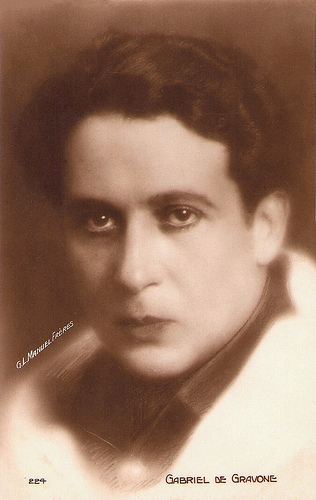
French postcard by Cinémagazine-Edition, no. 224. Photo: G.L. Manuel Frères.

French postcard by Cinémagazine, no. 71. Photo: Studio Rahma.
Capellani and Gance
Gabriel de Gravone was born Antoine Paul André Faggianelli in Ajaccio on the island Corsica, France, in 1887.
He started his career as film actor in 1909. Probably his first film was Un clair de lune sous Richelieu/A Ray of Moonlight on Richelieu (Albert Capellani, 1909), a period piece starring Paul Capellani .
The film was scripted by Abel Gance , who would later call him back for his masterpiece La Roue. Capellani directed Gravone a few times, most notably in the four part episode film Les Misérables (Albert Capellani, 1912, released 1913), in the role of Marius opposite Maria Fromet as Cosette.
Between 1912 and 1914 Gravone was the partner of Aimée Campton in the Pathé comedy series with the character 'Maud' and of Cauroy in the 'Papillon' comedies by Gaston Roudès. During the First World War, Gravone hardly acted in film.
In 1919 Louis Mercanton directed him in the feature L’appel du sang/The Call of the Blood, based on the novel by Robert Hichens and co-starring Charles Le Bargy and Ivor Novello .

Gabriel de Gravone as Marius in Les Miserables (1913), with Henry Krauss (left) as Jean Valjean, Léon Lérand as Gillesnormand and Marialise as Cosette. French postcard by E.L.D. Photo: Films Pathé Frères. Publicity still for Les Miserables (Albert Capellani, 1913). Caption: Les fiançailles de Marius et de Cosette (The betrothal of Marius and Cosette).
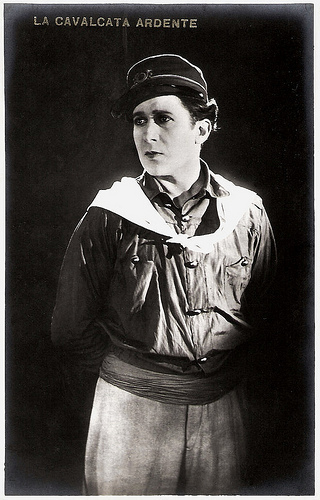
Italian postcard by Ed. G.B. Falci, Milano. Gabriel de Gravone in the Italian historical film La cavalcata ardente (Carmine Gallone 1925).
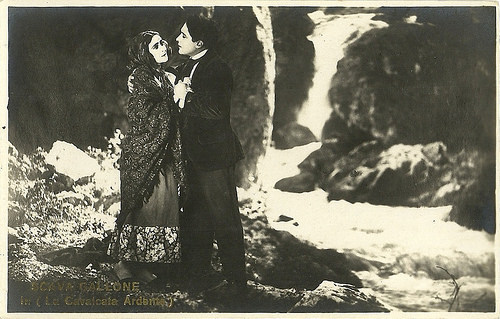
Soava Gallone and Gabriel de Gravone in La cavalcata ardente (1925). Italian postcard by Ed. G.B. Falci, Milano. no 318. Publicity still for La cavalcata ardente (Carmine Gallone, 1925).
La Roue
The film that gave Gabriel de Gravone lasting fame was the modern tragedy La Roue/The Wheel (Abel Gance, 1920-1923). Gravone played Élie, the son of Sisif ( Séverin-Mars ) and a passionate violinist.
Father and son are both in love with Sisif’s foster daughter Norma ( Ivy Close ), whom Sisif has once saved from a train wreck. His love for Norma turns Sisif violent and jealous, though, and when she leaves by train with Hersan (Pierre Magnier), an engineer from town, he almost wrecks the train. He is blinded by steam and is reduced to servicing a little funicular at the Mont-Blanc mountain, aided by his son Élie. When Norma returns with her now husband, love between Élie and Norma returns. Hersan, jealous, fights Élie and both men are killed, falling down. Norma stays to help the old and blind Sisif until his death.
After La Roue, Gravone became very active in the French silent cinema, until the mid-1920s. First he starred in the Alphonse Daudet adaptation L’Arlésienne (André Antoine, 1921), then in L’ombre du péché/The Shadow of Sin (Yakov Protazanov, 1922) with Diana Karenne , the Gaston Leroux adaptation Rouletabille chez les bohémiens (Henri Fescourt, 1922) with Édith Jéhanne , and Petit ange et son pantin/Small angel and his marionette (Luitz Morat, 1923).
Gabriel de Gravone also appeared Le mariage de minuit/The marriage at midnight (Armand Du Plessy, 1923) with Rita Jolivet , the Abbé Prevost adaptation Les demi-vierges/The half-virgins (Armand Du Plessy, 1924), and the ghost story Le manoir de la peur/The manor house of fear (Alfred Machin, Henri Wulschleger, 1924, released 1927) costarring Romuald Joubé.
His other films include Mimi Pinson (Théo Bergerat, 1922-1924) with Simone Vaudry , L’Ornière (Edouard Chimot, 1924) with Gabriel Signoret , and Michel Strogoff (Victor Tourjansky, 1925) starring Ivan Mozzhukhin .
In Italy, he made La cavalcata ardente/The ardent ride (Carmine Gallone, 1925) starring Soava Gallone , and finally de Gravone played the Biblical Abel in Le berceau de dieu/The Cradle of God (Fred Leroy-Granville, 1926).
In 1926, he also directed himself the film Paris, Cabourg, le Caire… et l’amour/Paris, Cabourg, Cairo... and Love (Gabriel de Gravone, 1928). After that he didn’t perform in films anymore.
Gabriel de Gravone died in Marseille in 1972. He was 85.
Scene from La Roue/The Wheel (1920-1923). Source: MoreTen (YouTube).
Sources: James Travers (Films de France), Cinema Francais, and .

French postcard by Cinémagazine-Edition, no. 224. Photo: G.L. Manuel Frères.

French postcard by Cinémagazine, no. 71. Photo: Studio Rahma.
Capellani and Gance
Gabriel de Gravone was born Antoine Paul André Faggianelli in Ajaccio on the island Corsica, France, in 1887.
He started his career as film actor in 1909. Probably his first film was Un clair de lune sous Richelieu/A Ray of Moonlight on Richelieu (Albert Capellani, 1909), a period piece starring Paul Capellani .
The film was scripted by Abel Gance , who would later call him back for his masterpiece La Roue. Capellani directed Gravone a few times, most notably in the four part episode film Les Misérables (Albert Capellani, 1912, released 1913), in the role of Marius opposite Maria Fromet as Cosette.
Between 1912 and 1914 Gravone was the partner of Aimée Campton in the Pathé comedy series with the character 'Maud' and of Cauroy in the 'Papillon' comedies by Gaston Roudès. During the First World War, Gravone hardly acted in film.
In 1919 Louis Mercanton directed him in the feature L’appel du sang/The Call of the Blood, based on the novel by Robert Hichens and co-starring Charles Le Bargy and Ivor Novello .

Gabriel de Gravone as Marius in Les Miserables (1913), with Henry Krauss (left) as Jean Valjean, Léon Lérand as Gillesnormand and Marialise as Cosette. French postcard by E.L.D. Photo: Films Pathé Frères. Publicity still for Les Miserables (Albert Capellani, 1913). Caption: Les fiançailles de Marius et de Cosette (The betrothal of Marius and Cosette).

Italian postcard by Ed. G.B. Falci, Milano. Gabriel de Gravone in the Italian historical film La cavalcata ardente (Carmine Gallone 1925).

Soava Gallone and Gabriel de Gravone in La cavalcata ardente (1925). Italian postcard by Ed. G.B. Falci, Milano. no 318. Publicity still for La cavalcata ardente (Carmine Gallone, 1925).
La Roue
The film that gave Gabriel de Gravone lasting fame was the modern tragedy La Roue/The Wheel (Abel Gance, 1920-1923). Gravone played Élie, the son of Sisif ( Séverin-Mars ) and a passionate violinist.
Father and son are both in love with Sisif’s foster daughter Norma ( Ivy Close ), whom Sisif has once saved from a train wreck. His love for Norma turns Sisif violent and jealous, though, and when she leaves by train with Hersan (Pierre Magnier), an engineer from town, he almost wrecks the train. He is blinded by steam and is reduced to servicing a little funicular at the Mont-Blanc mountain, aided by his son Élie. When Norma returns with her now husband, love between Élie and Norma returns. Hersan, jealous, fights Élie and both men are killed, falling down. Norma stays to help the old and blind Sisif until his death.
After La Roue, Gravone became very active in the French silent cinema, until the mid-1920s. First he starred in the Alphonse Daudet adaptation L’Arlésienne (André Antoine, 1921), then in L’ombre du péché/The Shadow of Sin (Yakov Protazanov, 1922) with Diana Karenne , the Gaston Leroux adaptation Rouletabille chez les bohémiens (Henri Fescourt, 1922) with Édith Jéhanne , and Petit ange et son pantin/Small angel and his marionette (Luitz Morat, 1923).
Gabriel de Gravone also appeared Le mariage de minuit/The marriage at midnight (Armand Du Plessy, 1923) with Rita Jolivet , the Abbé Prevost adaptation Les demi-vierges/The half-virgins (Armand Du Plessy, 1924), and the ghost story Le manoir de la peur/The manor house of fear (Alfred Machin, Henri Wulschleger, 1924, released 1927) costarring Romuald Joubé.
His other films include Mimi Pinson (Théo Bergerat, 1922-1924) with Simone Vaudry , L’Ornière (Edouard Chimot, 1924) with Gabriel Signoret , and Michel Strogoff (Victor Tourjansky, 1925) starring Ivan Mozzhukhin .
In Italy, he made La cavalcata ardente/The ardent ride (Carmine Gallone, 1925) starring Soava Gallone , and finally de Gravone played the Biblical Abel in Le berceau de dieu/The Cradle of God (Fred Leroy-Granville, 1926).
In 1926, he also directed himself the film Paris, Cabourg, le Caire… et l’amour/Paris, Cabourg, Cairo... and Love (Gabriel de Gravone, 1928). After that he didn’t perform in films anymore.
Gabriel de Gravone died in Marseille in 1972. He was 85.
Scene from La Roue/The Wheel (1920-1923). Source: MoreTen (YouTube).
Sources: James Travers (Films de France), Cinema Francais, and .
Published on March 10, 2018 22:00
March 9, 2018
James Dean
This thursday started the Roze Filmdagen (Pink Film Days) in Amsterdam, the largest film festival for LGBTQ films in the Netherlands. One of the films on the programme is the French comedy Ma vie avec James Dean/My Life with James Dean (Dominique Choisy, 2017) about a young director who is invited to show his newest film in a sleepy sea resort. American actor James Dean (1931-1955) was the quintessential 1950s teenager, brooding and romantic but he is also a gay icon. An air of androgyny attributes to his iconic appeal to both men and women. The three roles that defined his stardom are as troubled teenager Jim Stark in Rebel Without a Cause (1955), loner Cal Trask in East of Eden (1955) and surly ranch hand Jett Rink in Giant (1956). After his death in a car crash, the only 24-years-old Dean became the first actor to receive a posthumous Academy Award nomination for Best Actor.

Italian postcard by Rotalfoto, Milano, no. 519. Photo: Richard Miller / Warner Bros. Publicity still for Giant (George Stevens, 1956).

Italian postcard by Rotalfoto, Milano, no. 522. Photo: Richard Miller / Warner Bros. Publicity still for Giant (George Stevens, 1956).

French postcard by Editions P.I., offered by Les Carbones Korès 'Carboplane', no. 18. Photo: AFEX, Wien (Vienna). Photo: publicity still for East of Eden (Elia Kazan, 1955).
Struggling to get jobs in Hollywood
James Byron Dean was born in 1931, in Marion, Indiana, the only child of Winton Dean and Mildred Marie Wilson. Six years after his father had left farming to become a dental technician, Dean and his family moved to Santa Monica, California. In 1938, his mother was suddenly struck with acute stomach pain and quickly began to lose weight. She died of uterine cancer when Dean was nine years old.
Unable to care for his son, Dean's father sent him to live with his aunt and uncle, Ortense and Marcus Winslow, on their farm in Fairmount, Indiana, where he was raised in their Quaker household. Dean's overall performance in school was exceptional and he was a popular student. He played on the baseball and varsity basketball teams, studied drama, and competed in public speaking through the Indiana High School Forensic Association.
After graduating from Fairmount High School in May 1949, he moved back to California with his dog, Max, to live with his father and stepmother. He enrolled in Santa Monica College (SMC) and majored in pre-law. He transferred to UCLA for one semester and changed his major to drama, which resulted in estrangement from his father.
While at UCLA, Dean was picked from a group of 350 actors to portray Malcolm in Macbeth. At that time, he also began acting in James Whitmore's workshop. In January 1951, he dropped out of UCLA to pursue a full-time career as an actor.
Dean's first television appearance was in a Pepsi Cola commercial. His first speaking part was as John the Beloved Disciple, in Hill Number One (1951), an Easter television special dramatising the Resurrection of Jesus.
Dean subsequently obtained three walk-on roles in films: as a soldier in Samuel Fuller’s moody study of a platoon in the Korean War, Fixed Bayonets! (Samuel Fuller, 1951), a boxing cornerman in the Dean Martin and Jerry Lewis comedy Sailor Beware (Hal Walker, 1952), and a youth in the comedy Has Anybody Seen My Gal? (Douglas Sirk, 1952) with Rock Hudson.
While struggling to get jobs in Hollywood, Dean also worked as a parking lot attendant at CBS Studios, during which time he met Rogers Brackett, a radio director for an advertising agency, who offered him professional help and guidance in his chosen career, as well as a place to stay. In July 1951, Dean appeared on Alias Jane Doe, which was produced by Brackett.
In October 1951, Dean moved to New York City. There, he worked as a stunt tester for the game show Beat the Clock, but was subsequently fired for allegedly performing the tasks too quickly. He also appeared in episodes of several CBS television series like The Web, Studio One, and Lux Video Theatre, before gaining admission to the Actors Studio to study method acting under Lee Strasberg. There, he was classmates and close friends with Carroll Baker , alongside whom he would eventually star in Giant (George Stevens, 1956).
Dean's career picked up and he performed in further episodes of several early 1950s television. One early role, for the CBS series Omnibus in the episode Glory in the Flower (1953), saw Dean portraying the type of disaffected youth he would later portray in Rebel Without a Cause. Positive reviews for Dean's 1954 theatrical role as Bachir, the blackmailing Arab house boy, in an adaptation of André Gide's book The Immoralist, led to calls from Hollywood.

Dutch postcard by Uitg. Takken, Utrecht, no. 3685. Photo: Warner Bros. Dean photographed by Roy Schatt at Christmas 1954.

German postcard by Kolibri-Verlag G.m.b.H., no. 1983. Photo: Warner Bros.

German postcard by Kolibri-Verlag G.m.b.H., no. 2714. Photo: publicity still for Rebel Without a Cause (Nicholas Ray, 1955).
Angst-ridden protagonists and misunderstood outcasts
In 1954, James Dean was cast in the emotionally complex role of Cal Trask in East of Eden (Elia Kazan, 1955), an adaptation of John Steinbeck's 1952 novel East of Eden. The lengthy novel deals with the story of the Trask and Hamilton families over the course of three generations, focusing especially on the lives of the latter two generations in Salinas Valley, California, from the mid-19th century through the 1910s.
In contrast to the book, the film script focused on the last portion of the story, predominantly with the character of Cal. Though he initially seems more aloof and emotionally troubled than his twin brother Aron (Richard Davalos), Cal is soon seen to be more worldly, business savvy, and even sagacious than their pious and constantly disapproving father (Raymond Massey) who seeks to invent a vegetable refrigeration process. Cal is bothered by the mystery of their supposedly dead mother, and discovers she is still alive and a brothel-keeping 'madam'; the part was played by actress Jo Van Fleet.
Much of Dean's performance in the film was unscripted, including his dance in the bean field and his foetal-like posturing while riding on top of a train boxcar (after searching out his mother in nearby Monterey).
The most famous improvisation of the film occurs when Cal's father rejects his gift of $5,000, money Cal earned by speculating in beans before the US became involved in World War I. Instead of running away from his father as the script called for, Dean instinctively turned to Massey and in a gesture of extreme emotion, lunged forward and grabbed him in a full embrace, crying. Kazan kept this and Massey's shocked reaction in the film.
Wikipedia : “Dean's performance in the film foreshadowed his role as Jim Stark in Rebel Without A Cause. Both characters are angst-ridden protagonists and misunderstood outcasts, desperately craving approval from their fathers.”
In recognition of his performance in East of Eden, Dean was nominated posthumously for the 1956 Academy Awards as Best Actor in a Leading Role of 1955, the first official posthumous acting nomination in Academy Awards history. East of Eden was the only film starring Dean that he would see released in his lifetime.

British postcard in the Picturegoer Series, London, no. D 697. Photo: Warner. Publicity still for East of Eden (Elia Kazan, 1955).

German postcard by Kunst und Bild, Berlin, no. V 370. Photo: Warner Bros. Publicity still for East of Eden (Elia Kazan, 1955).
Brooding red-jacketed teenager
James Dean quickly followed up his role in Eden with a starring role as the brooding red-jacketed teenager Jim Stark in Rebel Without a Cause (Nicholas Ray, 1955) with Sal Mineo and Natalie Wood.
The film depicts the dilemma of a typical teenager of the time, who feels that no one, not even his peers, can understand him. The film scrupulously follows the classic theatrical disciplines, telling all within a 24-hour period.
Jim Stark was Dean’s true starring role, and Rebel Without a Cause proved to be hugely popular among teenagers. The landmark juvenile-delinquent drama fixed James Dean’s image forever in American culture.
In his next film, Giant (George Stevens, 1956), Dean played a supporting role to Elizabeth Taylor and Rock Hudson. This was due to his desire to avoid being typecast as a rebellious teenager like Cal Trask or Jim Stark.
In the film, he plays Jett Rink, a Texan ranch hand who strikes oil and becomes wealthy. His role was notable in that, in order to portray an older version of his character in the film's later scenes, Dean dyed his hair gray and shaved some of it off to give himself a receding hairline.
Giant would prove to be Dean's last film. At the end of the film, Dean was supposed to make a drunken speech at a banquet; this is nicknamed the 'Last Supper' because it was the last scene before his sudden death. Due to his desire to make the scene more realistic by actually being inebriated for the take, Dean mumbled so much that director George Stevens decided the scene had to be overdubbed.
This was done by Nick Adams, who had a small role in the film, because Dean had died before the film was edited. Dean received his second posthumous Best Actor Academy Award nomination for his role in Giant at the 29th Academy Awards in 1957 for films released in 1956.
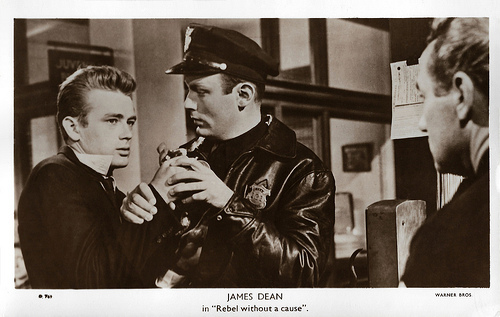
British postcard in the Picturegoer Series, London, no. D 769. Photo: Warner Bros. Publicity still for Rebel Without a Cause (Nicholas Ray, 1955).

British postcard in the Picturegoer Series, London, no. D 770. Photo: Warner Bros. Publicity still for Rebel Without a Cause (Nicholas Ray, 1955) with Sal Mineo.

British postcard in the Picturegoer Series, London, no. D 903. Photo: Warner Bros. Publicity still for Giant (George Stevens, 1956) with Elizabeth Taylor .
'The greatest male gay icon of all time'
Today, James Dean is often considered an icon because of his perceived experimental take on life, which included his ambivalent sexuality. Most of his so-called affairs with various starlets were made up by the Warner Brothers public relations.
Dean's best-remembered relationship was with young Italian actress Pier Angeli , whom he met while Angeli was shooting The Silver Chalice (Victor Saville, 1954) on an adjoining Warner lot, and with whom he exchanged items of jewelry as love tokens.
Angeli's Catholic mother disapproved of Dean. After finishing his role for East of Eden, he took a brief trip to New York in October 1954. While he was away, Angeli unexpectedly announced her engagement to Italian-American singer Vic Damone. The press was shocked and Dean expressed his irritation. Angeli married Damone the following month.
Dean also dated Swiss actress Ursula Andress . She was seen with Dean in his sports cars, and was with him on the day he bought the car that he died in.
A Gay Times Readers' Awards cited him as 'the greatest male gay icon of all time' and other gay media also mention him as an icon. Dean’s ambiguous relationship with Sal Mineo in the angst-ridden Rebel Without A Cause has led many to speculate and view this golden age film as years ahead of its time.
When questioned about his sexual orientation, Dean is reported to have said, "No, I am not a homosexual. But I'm also not going to go through life with one hand tied behind my back." Dean, with time on his side during down times of filming, often frequented gay bars in mornings, afternoons and evenings in both Hollywood, Studio City and North Hollywood.
Dean and screenwriter and theatre student from UCLA, William Bast lived together as roommates for a number of years. Bast later became Dean's first biographer and told he and Dean ‘experimented’ sexually.
Another biographer, journalist Joe Hyams suggests that any gay activity Dean might have been involved in appears to have been strictly "for trade", as a means of advancing his career. However, the ‘trade only’ notion is contradicted by Bast and other Dean biographers.
Biographer Val Holley: “There's been quite an evolution in the thinking since Dean's death in 1955, moving from ‘James Dean was straight’ to ‘Dean had sex with men but only to advance his career’ to ‘Dean had sex with women but only to advance his career.’
In 2016, a new gossipy biography was published, James Dean: Tomorrow Never Comes, by Darwin Porter and Danforth Prince. The authors claim Dean was in love with Marlon Brando and the two would have had a long sexual affair with S&M overtones.
We probably may never know for certain if Dean identified as gay, straight, bisexual, but, regardless, what he’s come to represent he still resonates with many LGBTQ audiences.
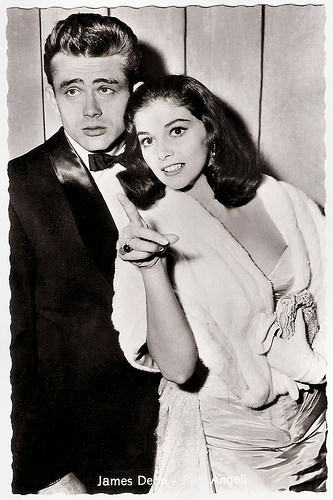
With Pier Angeli . German postcard by Kolibri-Verlag, Minden/Westf., no. 2346. Photo: Keystone.

Italian postcard by B.F.F. Edit., Firenze (Florence), no. 3435. Photo: Warner Bros. Publicity still for Giant (George Stevens, 1956).

Dutch postcard. Photo: Warner Bros.
A cult object of apparently timeless fascination
In 1954, James Dean had become interested in developing an auto racing career. He purchased various vehicles after filming for East of Eden had concluded, including a Triumph Tiger T110 and a Porsche 356.
Just before filming began on Rebel Without a Cause, he competed in his first professional event at the Palm Springs Road Races, which was held in Palm Springs, California on March 26–27, 1955. Dean achieved first place in the novice class, and second place at the main event.
His racing continued in Bakersfield a month later, where he finished first in his class and third overall. Dean hoped to compete in the Indianapolis 500, but his busy schedule made it impossible. Dean's final race occurred in Santa Barbara on Memorial Day, 30 May 1955. He was unable to finish the competition due to a blown piston.
His brief racing career was put on hold when Warner Brothers barred him from all racing during the production of Giant. Dean had finished shooting his scenes and the movie was in post-production when he decided to race again.
Dean was scheduled to compete at a racing event in Salinas, California on 30 September 1955. Accompanying the actor to the occasion was stunt coordinator Bill Hickman, Collier's photographer Sanford Roth, and Rolf Wütherich, the German mechanic from the Porsche factory who maintained Dean's Porsche 550 Spyder 'Little Bastard' car.
Wütherich, who had encouraged Dean to drive the car from Los Angeles to Salinas to break it in, accompanied Dean in the Porsche. At 3:30 p.m. Dean was ticketed for speeding, as was Hickman who was following behind in another car.
As the group travelled to the event via U.S. Route 466, (currently SR 46) at approximately 5:15 p.m. a 1950 Ford Tudor was passing through an intersection while turning, ahead of the Porsche. Dean, unable to stop in time, slammed into the driver's side of the Ford resulting in Dean's car bouncing across the pavement onto the side of the highway.
Dean's passenger, Wütherich, was thrown from the Porsche, while Dean was trapped in the car and sustained numerous fatal injuries, including a broken neck. The driver of the Ford, Donald Turnupseed, exited his damaged vehicle with minor injuries.
Dean was pronounced dead on arrival shortly after he arrived by ambulance at the Paso Robles War Memorial Hospital at 6:20 p.m. The Failure Analysis Associates later reconstructed and recreated all details of the accident and have concluded that James Dean was travelling 55 to 56 mph when the fateful accident occurred, thereby proving he had not been speeding, as rumour had it.
Ed Stephan at IMDb : “At age 24, James Dean was killed almost immediately from the impact from a broken neck. His very brief career, violent death and highly publicised funeral transformed him into a cult object of apparently timeless fascination.”

Italian postcard by Rotalfoto, Milano, no. 5.

French postcard by E.D.U.G., no. 92. Photo: publicity still for East of Eden (Elia Kazan, 1955).

German postcard by Kolibri-Verlag G.m.b.H., no. 314. Photo: Warner Bros. Publicity still for The James Dean Story (Robert Altman, George W. George, 1957). The documentary The James Dean Story was undertaken soon after James Dean's death. It includes East of Eden (1955) outtakes, shots from the opening night of Giant (1956), and Dean's TV safe driving message. Directors Robert Altman and George W. George look at Dean's life through the use of still photographs with narration, and interviews with many of the people involved in his short life. Interviewees include the aunt and uncle who raised him after his mother's death (when James was 9), his fraternal grandparents, a cabdriver friend in New York City, and the owner of his favourite restaurant in Los Angeles. James's father, who was alive when the film was made, does not get a single mention. Altman later would direct Come Back to the 5 & Dime, Jimmy Dean, Jimmy Dean (Robert Altman, 1982) in which the Disciples of James Dean meet up on the anniversary of his death.
Sources: Hal Erickson (AllMovie), David Glagovsky (IMDb), (IMDb), (Daily Mail), Towleroad, Wikipedia, and .

Italian postcard by Rotalfoto, Milano, no. 519. Photo: Richard Miller / Warner Bros. Publicity still for Giant (George Stevens, 1956).

Italian postcard by Rotalfoto, Milano, no. 522. Photo: Richard Miller / Warner Bros. Publicity still for Giant (George Stevens, 1956).

French postcard by Editions P.I., offered by Les Carbones Korès 'Carboplane', no. 18. Photo: AFEX, Wien (Vienna). Photo: publicity still for East of Eden (Elia Kazan, 1955).
Struggling to get jobs in Hollywood
James Byron Dean was born in 1931, in Marion, Indiana, the only child of Winton Dean and Mildred Marie Wilson. Six years after his father had left farming to become a dental technician, Dean and his family moved to Santa Monica, California. In 1938, his mother was suddenly struck with acute stomach pain and quickly began to lose weight. She died of uterine cancer when Dean was nine years old.
Unable to care for his son, Dean's father sent him to live with his aunt and uncle, Ortense and Marcus Winslow, on their farm in Fairmount, Indiana, where he was raised in their Quaker household. Dean's overall performance in school was exceptional and he was a popular student. He played on the baseball and varsity basketball teams, studied drama, and competed in public speaking through the Indiana High School Forensic Association.
After graduating from Fairmount High School in May 1949, he moved back to California with his dog, Max, to live with his father and stepmother. He enrolled in Santa Monica College (SMC) and majored in pre-law. He transferred to UCLA for one semester and changed his major to drama, which resulted in estrangement from his father.
While at UCLA, Dean was picked from a group of 350 actors to portray Malcolm in Macbeth. At that time, he also began acting in James Whitmore's workshop. In January 1951, he dropped out of UCLA to pursue a full-time career as an actor.
Dean's first television appearance was in a Pepsi Cola commercial. His first speaking part was as John the Beloved Disciple, in Hill Number One (1951), an Easter television special dramatising the Resurrection of Jesus.
Dean subsequently obtained three walk-on roles in films: as a soldier in Samuel Fuller’s moody study of a platoon in the Korean War, Fixed Bayonets! (Samuel Fuller, 1951), a boxing cornerman in the Dean Martin and Jerry Lewis comedy Sailor Beware (Hal Walker, 1952), and a youth in the comedy Has Anybody Seen My Gal? (Douglas Sirk, 1952) with Rock Hudson.
While struggling to get jobs in Hollywood, Dean also worked as a parking lot attendant at CBS Studios, during which time he met Rogers Brackett, a radio director for an advertising agency, who offered him professional help and guidance in his chosen career, as well as a place to stay. In July 1951, Dean appeared on Alias Jane Doe, which was produced by Brackett.
In October 1951, Dean moved to New York City. There, he worked as a stunt tester for the game show Beat the Clock, but was subsequently fired for allegedly performing the tasks too quickly. He also appeared in episodes of several CBS television series like The Web, Studio One, and Lux Video Theatre, before gaining admission to the Actors Studio to study method acting under Lee Strasberg. There, he was classmates and close friends with Carroll Baker , alongside whom he would eventually star in Giant (George Stevens, 1956).
Dean's career picked up and he performed in further episodes of several early 1950s television. One early role, for the CBS series Omnibus in the episode Glory in the Flower (1953), saw Dean portraying the type of disaffected youth he would later portray in Rebel Without a Cause. Positive reviews for Dean's 1954 theatrical role as Bachir, the blackmailing Arab house boy, in an adaptation of André Gide's book The Immoralist, led to calls from Hollywood.

Dutch postcard by Uitg. Takken, Utrecht, no. 3685. Photo: Warner Bros. Dean photographed by Roy Schatt at Christmas 1954.

German postcard by Kolibri-Verlag G.m.b.H., no. 1983. Photo: Warner Bros.

German postcard by Kolibri-Verlag G.m.b.H., no. 2714. Photo: publicity still for Rebel Without a Cause (Nicholas Ray, 1955).
Angst-ridden protagonists and misunderstood outcasts
In 1954, James Dean was cast in the emotionally complex role of Cal Trask in East of Eden (Elia Kazan, 1955), an adaptation of John Steinbeck's 1952 novel East of Eden. The lengthy novel deals with the story of the Trask and Hamilton families over the course of three generations, focusing especially on the lives of the latter two generations in Salinas Valley, California, from the mid-19th century through the 1910s.
In contrast to the book, the film script focused on the last portion of the story, predominantly with the character of Cal. Though he initially seems more aloof and emotionally troubled than his twin brother Aron (Richard Davalos), Cal is soon seen to be more worldly, business savvy, and even sagacious than their pious and constantly disapproving father (Raymond Massey) who seeks to invent a vegetable refrigeration process. Cal is bothered by the mystery of their supposedly dead mother, and discovers she is still alive and a brothel-keeping 'madam'; the part was played by actress Jo Van Fleet.
Much of Dean's performance in the film was unscripted, including his dance in the bean field and his foetal-like posturing while riding on top of a train boxcar (after searching out his mother in nearby Monterey).
The most famous improvisation of the film occurs when Cal's father rejects his gift of $5,000, money Cal earned by speculating in beans before the US became involved in World War I. Instead of running away from his father as the script called for, Dean instinctively turned to Massey and in a gesture of extreme emotion, lunged forward and grabbed him in a full embrace, crying. Kazan kept this and Massey's shocked reaction in the film.
Wikipedia : “Dean's performance in the film foreshadowed his role as Jim Stark in Rebel Without A Cause. Both characters are angst-ridden protagonists and misunderstood outcasts, desperately craving approval from their fathers.”
In recognition of his performance in East of Eden, Dean was nominated posthumously for the 1956 Academy Awards as Best Actor in a Leading Role of 1955, the first official posthumous acting nomination in Academy Awards history. East of Eden was the only film starring Dean that he would see released in his lifetime.

British postcard in the Picturegoer Series, London, no. D 697. Photo: Warner. Publicity still for East of Eden (Elia Kazan, 1955).

German postcard by Kunst und Bild, Berlin, no. V 370. Photo: Warner Bros. Publicity still for East of Eden (Elia Kazan, 1955).
Brooding red-jacketed teenager
James Dean quickly followed up his role in Eden with a starring role as the brooding red-jacketed teenager Jim Stark in Rebel Without a Cause (Nicholas Ray, 1955) with Sal Mineo and Natalie Wood.
The film depicts the dilemma of a typical teenager of the time, who feels that no one, not even his peers, can understand him. The film scrupulously follows the classic theatrical disciplines, telling all within a 24-hour period.
Jim Stark was Dean’s true starring role, and Rebel Without a Cause proved to be hugely popular among teenagers. The landmark juvenile-delinquent drama fixed James Dean’s image forever in American culture.
In his next film, Giant (George Stevens, 1956), Dean played a supporting role to Elizabeth Taylor and Rock Hudson. This was due to his desire to avoid being typecast as a rebellious teenager like Cal Trask or Jim Stark.
In the film, he plays Jett Rink, a Texan ranch hand who strikes oil and becomes wealthy. His role was notable in that, in order to portray an older version of his character in the film's later scenes, Dean dyed his hair gray and shaved some of it off to give himself a receding hairline.
Giant would prove to be Dean's last film. At the end of the film, Dean was supposed to make a drunken speech at a banquet; this is nicknamed the 'Last Supper' because it was the last scene before his sudden death. Due to his desire to make the scene more realistic by actually being inebriated for the take, Dean mumbled so much that director George Stevens decided the scene had to be overdubbed.
This was done by Nick Adams, who had a small role in the film, because Dean had died before the film was edited. Dean received his second posthumous Best Actor Academy Award nomination for his role in Giant at the 29th Academy Awards in 1957 for films released in 1956.

British postcard in the Picturegoer Series, London, no. D 769. Photo: Warner Bros. Publicity still for Rebel Without a Cause (Nicholas Ray, 1955).

British postcard in the Picturegoer Series, London, no. D 770. Photo: Warner Bros. Publicity still for Rebel Without a Cause (Nicholas Ray, 1955) with Sal Mineo.

British postcard in the Picturegoer Series, London, no. D 903. Photo: Warner Bros. Publicity still for Giant (George Stevens, 1956) with Elizabeth Taylor .
'The greatest male gay icon of all time'
Today, James Dean is often considered an icon because of his perceived experimental take on life, which included his ambivalent sexuality. Most of his so-called affairs with various starlets were made up by the Warner Brothers public relations.
Dean's best-remembered relationship was with young Italian actress Pier Angeli , whom he met while Angeli was shooting The Silver Chalice (Victor Saville, 1954) on an adjoining Warner lot, and with whom he exchanged items of jewelry as love tokens.
Angeli's Catholic mother disapproved of Dean. After finishing his role for East of Eden, he took a brief trip to New York in October 1954. While he was away, Angeli unexpectedly announced her engagement to Italian-American singer Vic Damone. The press was shocked and Dean expressed his irritation. Angeli married Damone the following month.
Dean also dated Swiss actress Ursula Andress . She was seen with Dean in his sports cars, and was with him on the day he bought the car that he died in.
A Gay Times Readers' Awards cited him as 'the greatest male gay icon of all time' and other gay media also mention him as an icon. Dean’s ambiguous relationship with Sal Mineo in the angst-ridden Rebel Without A Cause has led many to speculate and view this golden age film as years ahead of its time.
When questioned about his sexual orientation, Dean is reported to have said, "No, I am not a homosexual. But I'm also not going to go through life with one hand tied behind my back." Dean, with time on his side during down times of filming, often frequented gay bars in mornings, afternoons and evenings in both Hollywood, Studio City and North Hollywood.
Dean and screenwriter and theatre student from UCLA, William Bast lived together as roommates for a number of years. Bast later became Dean's first biographer and told he and Dean ‘experimented’ sexually.
Another biographer, journalist Joe Hyams suggests that any gay activity Dean might have been involved in appears to have been strictly "for trade", as a means of advancing his career. However, the ‘trade only’ notion is contradicted by Bast and other Dean biographers.
Biographer Val Holley: “There's been quite an evolution in the thinking since Dean's death in 1955, moving from ‘James Dean was straight’ to ‘Dean had sex with men but only to advance his career’ to ‘Dean had sex with women but only to advance his career.’
In 2016, a new gossipy biography was published, James Dean: Tomorrow Never Comes, by Darwin Porter and Danforth Prince. The authors claim Dean was in love with Marlon Brando and the two would have had a long sexual affair with S&M overtones.
We probably may never know for certain if Dean identified as gay, straight, bisexual, but, regardless, what he’s come to represent he still resonates with many LGBTQ audiences.

With Pier Angeli . German postcard by Kolibri-Verlag, Minden/Westf., no. 2346. Photo: Keystone.

Italian postcard by B.F.F. Edit., Firenze (Florence), no. 3435. Photo: Warner Bros. Publicity still for Giant (George Stevens, 1956).

Dutch postcard. Photo: Warner Bros.
A cult object of apparently timeless fascination
In 1954, James Dean had become interested in developing an auto racing career. He purchased various vehicles after filming for East of Eden had concluded, including a Triumph Tiger T110 and a Porsche 356.
Just before filming began on Rebel Without a Cause, he competed in his first professional event at the Palm Springs Road Races, which was held in Palm Springs, California on March 26–27, 1955. Dean achieved first place in the novice class, and second place at the main event.
His racing continued in Bakersfield a month later, where he finished first in his class and third overall. Dean hoped to compete in the Indianapolis 500, but his busy schedule made it impossible. Dean's final race occurred in Santa Barbara on Memorial Day, 30 May 1955. He was unable to finish the competition due to a blown piston.
His brief racing career was put on hold when Warner Brothers barred him from all racing during the production of Giant. Dean had finished shooting his scenes and the movie was in post-production when he decided to race again.
Dean was scheduled to compete at a racing event in Salinas, California on 30 September 1955. Accompanying the actor to the occasion was stunt coordinator Bill Hickman, Collier's photographer Sanford Roth, and Rolf Wütherich, the German mechanic from the Porsche factory who maintained Dean's Porsche 550 Spyder 'Little Bastard' car.
Wütherich, who had encouraged Dean to drive the car from Los Angeles to Salinas to break it in, accompanied Dean in the Porsche. At 3:30 p.m. Dean was ticketed for speeding, as was Hickman who was following behind in another car.
As the group travelled to the event via U.S. Route 466, (currently SR 46) at approximately 5:15 p.m. a 1950 Ford Tudor was passing through an intersection while turning, ahead of the Porsche. Dean, unable to stop in time, slammed into the driver's side of the Ford resulting in Dean's car bouncing across the pavement onto the side of the highway.
Dean's passenger, Wütherich, was thrown from the Porsche, while Dean was trapped in the car and sustained numerous fatal injuries, including a broken neck. The driver of the Ford, Donald Turnupseed, exited his damaged vehicle with minor injuries.
Dean was pronounced dead on arrival shortly after he arrived by ambulance at the Paso Robles War Memorial Hospital at 6:20 p.m. The Failure Analysis Associates later reconstructed and recreated all details of the accident and have concluded that James Dean was travelling 55 to 56 mph when the fateful accident occurred, thereby proving he had not been speeding, as rumour had it.
Ed Stephan at IMDb : “At age 24, James Dean was killed almost immediately from the impact from a broken neck. His very brief career, violent death and highly publicised funeral transformed him into a cult object of apparently timeless fascination.”

Italian postcard by Rotalfoto, Milano, no. 5.

French postcard by E.D.U.G., no. 92. Photo: publicity still for East of Eden (Elia Kazan, 1955).

German postcard by Kolibri-Verlag G.m.b.H., no. 314. Photo: Warner Bros. Publicity still for The James Dean Story (Robert Altman, George W. George, 1957). The documentary The James Dean Story was undertaken soon after James Dean's death. It includes East of Eden (1955) outtakes, shots from the opening night of Giant (1956), and Dean's TV safe driving message. Directors Robert Altman and George W. George look at Dean's life through the use of still photographs with narration, and interviews with many of the people involved in his short life. Interviewees include the aunt and uncle who raised him after his mother's death (when James was 9), his fraternal grandparents, a cabdriver friend in New York City, and the owner of his favourite restaurant in Los Angeles. James's father, who was alive when the film was made, does not get a single mention. Altman later would direct Come Back to the 5 & Dime, Jimmy Dean, Jimmy Dean (Robert Altman, 1982) in which the Disciples of James Dean meet up on the anniversary of his death.
Sources: Hal Erickson (AllMovie), David Glagovsky (IMDb), (IMDb), (Daily Mail), Towleroad, Wikipedia, and .
Published on March 09, 2018 22:00
Paul van Yperen's Blog
- Paul van Yperen's profile
- 13 followers
Paul van Yperen isn't a Goodreads Author
(yet),
but they
do have a blog,
so here are some recent posts imported from
their feed.



